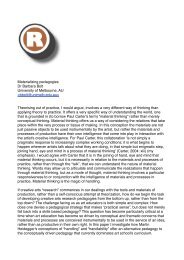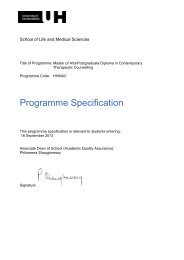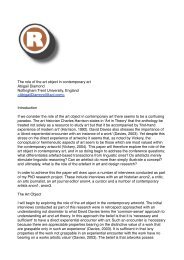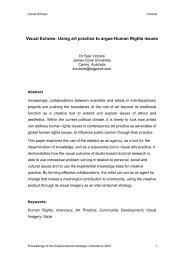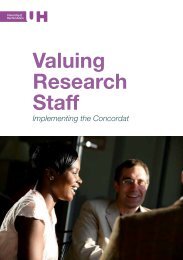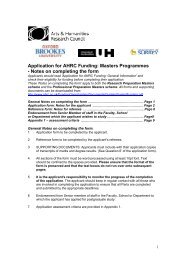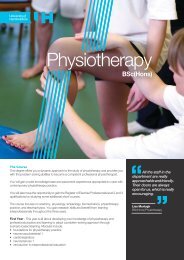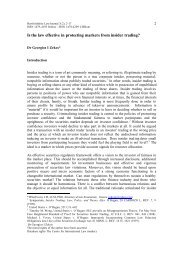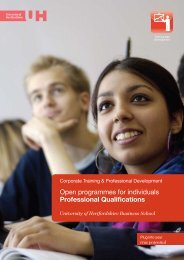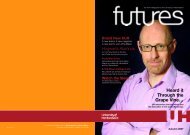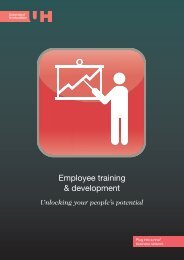Blended Learning in Practice - University of Hertfordshire
Blended Learning in Practice - University of Hertfordshire
Blended Learning in Practice - University of Hertfordshire
- No tags were found...
You also want an ePaper? Increase the reach of your titles
YUMPU automatically turns print PDFs into web optimized ePapers that Google loves.
2ContentsEditorialPhil Porter3Contributor Pr<strong>of</strong>ilesPhil Porter, Andy Saunders, Peter Ross, Suzanne FergusArticles6Apply<strong>in</strong>g work-based learn<strong>in</strong>g practice andtheories to the employability skills and learn<strong>in</strong>gopportunities <strong>of</strong> undergraduates on music <strong>in</strong>dustryrelated academic courses.Andy Saunders8Ten Top tips to liven up your lectures!Phil Porter and Suzanne Fergus19A Physiotherapy practice educators reflectionupon changes <strong>in</strong> teach<strong>in</strong>g carried out for studentpractice placementsPeter Ross30Student VoiceStudent views on traditional lectures, smallgroup teach<strong>in</strong>g, fieldwork and practical teach<strong>in</strong>g50<strong>Blended</strong> <strong>Learn<strong>in</strong>g</strong> In <strong>Practice</strong> July 2013
3 EditorialWelcome to the latest edition <strong>of</strong> <strong>Blended</strong> <strong>Learn<strong>in</strong>g</strong> <strong>in</strong><strong>Practice</strong>, the <strong>University</strong> <strong>of</strong> <strong>Hertfordshire</strong> <strong>Learn<strong>in</strong>g</strong> andTeach<strong>in</strong>g <strong>in</strong>stitute’s onl<strong>in</strong>e e-journal.As usual we present our regular ‘how to do it’ sectionwhere Suzanne Fergus and I provide some h<strong>in</strong>ts andtips to help you liven up your lectures!Lectures then form part <strong>of</strong> the discussion <strong>in</strong> our ‘student Phil Portervoice’ section; <strong>University</strong> <strong>of</strong> <strong>Hertfordshire</strong> students share their op<strong>in</strong>ions on avariety <strong>of</strong> common teach<strong>in</strong>g methods and as is <strong>of</strong>ten the case, the viewpo<strong>in</strong>tsexpressed may not be quite what you expect!This edition is also a celebration <strong>of</strong> success, as our two research papers arepresented by two recently graduated students from our Cont<strong>in</strong>u<strong>in</strong>gPr<strong>of</strong>essional Academic Development (CPAD) programme. Andy Saundersdiscusses the importance <strong>of</strong> work-based learn<strong>in</strong>g and employability tostudents seek<strong>in</strong>g employment <strong>in</strong> the music <strong>in</strong>dustry, while Peter Rossassesses the pedagogic implications <strong>of</strong> a variety <strong>of</strong> teach<strong>in</strong>g methods used toprovide <strong>in</strong>-service tra<strong>in</strong><strong>in</strong>g for physiotherapy students. Of note is the fact thatboth these papers were orig<strong>in</strong>ally submitted as an assessed courseworkelement <strong>of</strong> one <strong>of</strong> our CPAD modules and have subsequently been developedby Andy and Peter for publication.This then br<strong>in</strong>gs me to the sadness with which this edition <strong>of</strong> <strong>Blended</strong> <strong>Learn<strong>in</strong>g</strong><strong>in</strong> <strong>Practice</strong> is t<strong>in</strong>ged, as it is the first edition to be published s<strong>in</strong>ce theunexpected death <strong>of</strong> our friend and colleague Areles Molleman <strong>in</strong> September2012.Areles was a pivotal figure <strong>in</strong> the CPAD team and was <strong>in</strong>strumental <strong>in</strong> help<strong>in</strong>gto re-design the CPAD programme when he jo<strong>in</strong>ed the <strong>Learn<strong>in</strong>g</strong> and Teach<strong>in</strong>gInstitute <strong>in</strong> 2008. Areles was also module leader for the third <strong>of</strong> our four CPADmodules, now entitled ‘L<strong>in</strong>k<strong>in</strong>g Pedagogic Theory with <strong>Practice</strong>’ and I wasprivileged to work with him when I took over the leadership <strong>of</strong> this module last<strong>Blended</strong> <strong>Learn<strong>in</strong>g</strong> In <strong>Practice</strong> July 2013
4 Editorialyear. Areles <strong>in</strong>spired and enthused all whom he came <strong>in</strong>to contact with and hiscalm and friendly nature made him a pleasure to work with.It is therefore fitt<strong>in</strong>g that we should publish here two papers <strong>in</strong>itially submitted aspart <strong>of</strong> the assessment on the CPAD module that he led. Areles implemented anassessment on that module where student work was to be submitted <strong>in</strong> the style<strong>of</strong> a journal article. It was the possibility <strong>of</strong> work<strong>in</strong>g these journal articles <strong>in</strong>to apublishable form that proved to be a def<strong>in</strong><strong>in</strong>g moment when <strong>in</strong> 2009 I wasdiscuss<strong>in</strong>g with colleagues the format <strong>of</strong> <strong>Blended</strong> <strong>Learn<strong>in</strong>g</strong> <strong>in</strong> <strong>Practice</strong>. I amtherefore delighted that we have been able to work with CPAD participants s<strong>in</strong>ce2009 to develop their work <strong>in</strong>to a publishable format as a key component <strong>of</strong> eachedition <strong>of</strong> the journal. The <strong>in</strong>novative assessment implemented by Areles hasresulted <strong>in</strong> great opportunities for staff study<strong>in</strong>g on the Postgraduate Certificate <strong>in</strong><strong>Learn<strong>in</strong>g</strong> and Teach<strong>in</strong>g <strong>in</strong> Higher Education, and this assessment will cont<strong>in</strong>ue todo so, as we see staff submitt<strong>in</strong>g their work for publication <strong>in</strong> <strong>Blended</strong> <strong>Learn<strong>in</strong>g</strong> <strong>in</strong><strong>Practice</strong> and elsewhere. What a wonderful legacy he has left us.Areles will be sorely missed by us all and <strong>in</strong> his memory we will each year atgraduation, award the Areles Molleman prize for the best journal articleassignment submitted as part <strong>of</strong> the module ‘L<strong>in</strong>k<strong>in</strong>g Pedagogic Theory with<strong>Practice</strong>’. We believe that this prize is a fitt<strong>in</strong>g gesture that acknowledges not justAreles’ massive contribution to the LTI, but also the fact that this journal and itspromotion <strong>of</strong> pedagogic research talent <strong>in</strong> the form <strong>of</strong> published CPAD researchpapers, is <strong>in</strong>extricably l<strong>in</strong>ked with the <strong>in</strong>novative assessment methods that he<strong>in</strong>troduced and developed.Dr Phil PorterEditor, <strong>Blended</strong> <strong>Learn<strong>in</strong>g</strong> <strong>in</strong> <strong>Practice</strong>p.r.porter@herts.ac.uk<strong>Blended</strong> <strong>Learn<strong>in</strong>g</strong> In <strong>Practice</strong> July 2013
5 In MemoryIn memory <strong>of</strong> our friend and colleagueAreles Molleman8 th November 1960-3 rd September 2012<strong>Blended</strong> <strong>Learn<strong>in</strong>g</strong> In <strong>Practice</strong> July 2013
6 Contributor Pr<strong>of</strong>ilesAlong with be<strong>in</strong>g the editor <strong>of</strong> <strong>Blended</strong> <strong>Learn<strong>in</strong>g</strong> <strong>in</strong> <strong>Practice</strong>, PhilPorter is a Senior Lecturer <strong>in</strong> Physical Geography at the <strong>University</strong><strong>of</strong> <strong>Hertfordshire</strong> <strong>in</strong> the School <strong>of</strong> Life and Medical Sciences andhas been active <strong>in</strong> glaciological research s<strong>in</strong>ce 1993. After complet<strong>in</strong>ga PhD (Leeds) <strong>in</strong> borehole <strong>in</strong>strumentation <strong>of</strong> fast flow<strong>in</strong>gglaciers, Phil took up lectureships at Manchester and Leeds andjo<strong>in</strong>ed the <strong>University</strong> <strong>of</strong> <strong>Hertfordshire</strong> <strong>in</strong> 2003. His current research<strong>in</strong>terests concern the response <strong>of</strong> the cryosphere to environmentalchange. Phil is also a LTI teacher tak<strong>in</strong>g a lead on ‘research <strong>in</strong>formedteach<strong>in</strong>g‘ and is currently work<strong>in</strong>g with undergraduate studentsto film and edit a series <strong>of</strong> reusable learn<strong>in</strong>g objects (RLOs)that will help students and educators <strong>in</strong> the earth and environmentalsciences teach specific field skills. The ‘under construction’website that hosts these RLOs can be viewed at: http://sarahnolan15.wix.com/fieldworkforstudents#!video-menu/cuptPhil Porterp.r.porter@herts.ac.ukAndy Saundersa.saunders05@herts.ac.ukAndy Saunders is a Lecturer <strong>in</strong> Music and Enterta<strong>in</strong>ment IndustriesManagement at the <strong>University</strong> <strong>of</strong> <strong>Hertfordshire</strong>. After graduat<strong>in</strong>g fromMiddlesex Polytechnic <strong>in</strong> with a BA <strong>in</strong> Comb<strong>in</strong>ed Studies <strong>in</strong> 1987,Andy start<strong>in</strong>g work at a small <strong>in</strong>dependent record company, his firstjob <strong>in</strong> a career that would see him work<strong>in</strong>g for almost 25 years at asenior level <strong>in</strong> the British music <strong>in</strong>dustry. After a ten-year tenure asDirector <strong>of</strong> Communications at Creation Records, Andy launched VelocityCommunications <strong>in</strong> 2000, which rema<strong>in</strong>s one <strong>of</strong> the UK’s lead<strong>in</strong>gcorporate PR and market<strong>in</strong>g companies, specialis<strong>in</strong>g <strong>in</strong> music<strong>in</strong>dustry work. His current clients <strong>in</strong>clude <strong>in</strong>dustry trade organisations,record labels, digital music companies, artist managers, music publishersand major conference and festival events. Andy is also a Fellow<strong>of</strong> the Higher Education Academy.<strong>Blended</strong> <strong>Learn<strong>in</strong>g</strong> In <strong>Practice</strong> July 2013
7 Contributor Pr<strong>of</strong>ilesPeter RossPeter graduated from Brunel <strong>University</strong> <strong>in</strong> 1995 as a Physiotherapist andsubsequently worked cl<strong>in</strong>ically <strong>in</strong> many different specialities, both here <strong>in</strong> theUK and <strong>in</strong> New Zealand. In 2002 Peter became a Cl<strong>in</strong>ical Specialist/Super<strong>in</strong>tendent Physiotherapist specialis<strong>in</strong>g <strong>in</strong> vascular surgery and amputeerehabilitation. He was also responsible for the education & mentor<strong>in</strong>g <strong>of</strong>all undergraduate physiotherapy students as well as a range <strong>of</strong> qualified &non-qualified junior staff. In 2007 Peter began work<strong>in</strong>g as a visit<strong>in</strong>g lectureron the undergraduate Physiotherapy courses at Brunel <strong>University</strong>, and hereat the <strong>University</strong> <strong>of</strong> <strong>Hertfordshire</strong>, where he also began an MSc <strong>in</strong> Physiotherapy-Cl<strong>in</strong>icalEducation. This was completed <strong>in</strong> 2010. He has also beenan active member <strong>of</strong> the British Association <strong>of</strong> Charted Physiotherapists <strong>in</strong>Amputee Rehabilitation (BACPAR) s<strong>in</strong>ce 2000 and has also recently beenco-opted on to the Educational sub-committee where he is currently coauthor<strong>in</strong>gthe revised ‘BACPAR Student Guidel<strong>in</strong>es’. In 2010 Peter jo<strong>in</strong>edthe <strong>University</strong> <strong>of</strong> <strong>Hertfordshire</strong> as a full time Senior Lecture <strong>in</strong> Physiotherapy,where he teaches on a wide variety <strong>of</strong> undergraduate modules and postgraduateshort courses .p.ross2@herts.ac.ukSuzanne FergusS.Fergus@herts.ac.ukSuzanne Fergus is currently a Senior Lecturer <strong>in</strong> PharmaceuticalChemistry with<strong>in</strong> the School <strong>of</strong> Life and Medical Sciencesand also a Pr<strong>in</strong>cipal Lecturer with the <strong>Learn<strong>in</strong>g</strong> and Teach<strong>in</strong>gInstitute at the <strong>University</strong> <strong>of</strong> <strong>Hertfordshire</strong>. Suzanne completedher PhD at <strong>University</strong> College Dubl<strong>in</strong> and then carried outpostdoctoral research at the <strong>University</strong> <strong>of</strong> Milan and the <strong>University</strong><strong>of</strong> Cambridge. Her research <strong>in</strong>terests focus on studentlearn<strong>in</strong>g, student motivation and student engagement. Suzannehas contributed significantly to curriculum design with<strong>in</strong>her discipl<strong>in</strong>e <strong>in</strong> order to contextualise chemistry for pharmacystudents. She has utilised new technologies (student generatedcontent us<strong>in</strong>g a wiki and peerwise) <strong>in</strong> her practice andshares these concepts and approaches with other staff at the<strong>University</strong> <strong>of</strong> <strong>Hertfordshire</strong> through CPD workshops and activities.<strong>Blended</strong> <strong>Learn<strong>in</strong>g</strong> In <strong>Practice</strong> July 2013
Apply<strong>in</strong>g work-based learn<strong>in</strong>g practice and theories to the employability skills and learn<strong>in</strong>g opportunities <strong>of</strong> music students8Apply<strong>in</strong>g work-based learn<strong>in</strong>g practice and theories to the employability skills andlearn<strong>in</strong>g opportunities <strong>of</strong> music studentsAndy Saunders<strong>University</strong> <strong>of</strong> <strong>Hertfordshire</strong>a.saunders05@herts.ac.ukAbstractThe music <strong>in</strong>dustry is a highly fragmented commercial sector, which is fac<strong>in</strong>g majorchallenges and undergo<strong>in</strong>g rapid change. When evaluat<strong>in</strong>g potential employeesdur<strong>in</strong>g a time that key roles are evolv<strong>in</strong>g to meet the demands <strong>of</strong> the contemporarymarketplace, the music <strong>in</strong>dustry attaches real credence and weight to practicalexperience <strong>in</strong> addition to academic achievement. This article considers theimportance <strong>of</strong> students not concentrat<strong>in</strong>g solely on their academic work, but alsoapply<strong>in</strong>g focus on acquir<strong>in</strong>g employability skills, experience and work-basedknowledge. For example, highly structured, short–term, work-based learn<strong>in</strong>g activitiesand the knowledge and employability skills these opportunities provide studentsare considered. Look<strong>in</strong>g at how various learn<strong>in</strong>g styles and theories can beapplied to enhance the experience <strong>of</strong> <strong>in</strong>dividual students, it is clear that, althoughmost music <strong>in</strong>dustry related companies <strong>of</strong>fer work placement opportunities whichare unstructured, the <strong>in</strong>tegration <strong>of</strong> activities such as reflective and analytical dissertationsaimed at build<strong>in</strong>g self-awareness, self-reflection and self-confidence,are just as important as practical experience and can cater for the needs <strong>of</strong> a diverserange <strong>of</strong> learn<strong>in</strong>g styles.IntroductionThe formal study <strong>of</strong> music <strong>in</strong>dustry history, theory and structure is a relatively newaddition to the roster <strong>of</strong> academic options available at most universities. As suchthe direction, shape and output <strong>of</strong> these courses is, <strong>in</strong> most cases, still evolv<strong>in</strong>g. Ata time when the music <strong>in</strong>dustry is fac<strong>in</strong>g significant challenges <strong>in</strong> terms <strong>of</strong> fall<strong>in</strong>gproduct sales and decl<strong>in</strong><strong>in</strong>g revenues across most <strong>of</strong> its sectors accord<strong>in</strong>g to theInternational Federation <strong>of</strong> the Phonographic Industry (IFPI, 2012), universities<strong>Blended</strong> <strong>Learn<strong>in</strong>g</strong> In <strong>Practice</strong> July 2013
Apply<strong>in</strong>g work-based learn<strong>in</strong>g practice and theories to the employability skills and learn<strong>in</strong>g opportunities <strong>of</strong> music students9are fac<strong>in</strong>g questions from both undergraduates and the <strong>in</strong>dustry about how best todesign these relevant music-based courses to ensure a tangible benefit for all <strong>in</strong>volved.In particular, with employment opportunities <strong>in</strong> the <strong>in</strong>dustry becom<strong>in</strong>g evermore limited, key questions be<strong>in</strong>g asked <strong>in</strong>clude: how much do work placementswith<strong>in</strong> companies operat<strong>in</strong>g <strong>in</strong> the music <strong>in</strong>dustry sector help undergraduates withtheir studies and how, <strong>in</strong> turn, does this add to their learn<strong>in</strong>g and atta<strong>in</strong>ment <strong>of</strong>practical experience, knowledge and future employability? This article will exam<strong>in</strong>ewhether undergraduates undertak<strong>in</strong>g the type <strong>of</strong> courses that purport to <strong>of</strong>fer a holisticoverview <strong>of</strong> the music <strong>in</strong>dustry, should have a reasonable expectation <strong>of</strong> employabilityat the conclusion <strong>of</strong> their studies. In addition it will exam<strong>in</strong>e whether undergraduatesundertak<strong>in</strong>g relevant and productive work- based learn<strong>in</strong>g and workplacements are, as a result, <strong>in</strong> a position to fulfill the requirements <strong>of</strong> employers.The music <strong>in</strong>dustry’s attitude to graduates seek<strong>in</strong>g employmentThe music bus<strong>in</strong>ess is a multi-faceted <strong>in</strong>dustry with numerous sectors compet<strong>in</strong>gaga<strong>in</strong>st one another for a share <strong>of</strong> rapidly decl<strong>in</strong><strong>in</strong>g consumer revenues. Accord<strong>in</strong>gto the British Phonographic Industry (BPI, 2012) <strong>of</strong>ficial website, “the musicbus<strong>in</strong>ess is composed <strong>of</strong> rich, diverse and passionate organisations…that <strong>in</strong>cludesself-employed <strong>in</strong>dividuals, small bus<strong>in</strong>esses and large multi-national companies.”The modern music <strong>in</strong>dustry has evolved along highly entrepreneurial l<strong>in</strong>eswith few obviously def<strong>in</strong>ed career paths. While some <strong>of</strong> the larger companies, particularlythe major record companies (e.g. Sony Music Enterta<strong>in</strong>ment, Warner MusicGroup and Universal Music Group), do <strong>of</strong>fer structured graduate entryschemes, the majority <strong>of</strong> companies do not. Employability rema<strong>in</strong>s a key challengefor any university course but particularly for those courses with a vocational emphasis.The Confederation <strong>of</strong> British Industry (2011) stated that, “Universities, studentunions, bus<strong>in</strong>esses and other agencies….have an essential role to play <strong>in</strong>gett<strong>in</strong>g the message across to students about the importance <strong>of</strong> shap<strong>in</strong>g up theiremployability and giv<strong>in</strong>g them ways to develop and practice these essential skills.”In addition Brown et al (2002) quotes one human resources manager as say<strong>in</strong>g,“academic qualifications are the first tick <strong>in</strong> the box and then we move on.<strong>Blended</strong> <strong>Learn<strong>in</strong>g</strong> In <strong>Practice</strong> July 2013
Apply<strong>in</strong>g work-based learn<strong>in</strong>g practice and theories to the employability skills and learn<strong>in</strong>g opportunities <strong>of</strong> music students10Today we simply take them for granted.” It is also worth not<strong>in</strong>g that the traditionalentry po<strong>in</strong>ts for those want<strong>in</strong>g a career <strong>in</strong> the music <strong>in</strong>dustry have tended to be eitherunpaid <strong>in</strong>ternships, junior positions or recommendations through personal networkswith the employee then work<strong>in</strong>g their way ‘up the ladder’ to more seniormanagerial positions. The atta<strong>in</strong>ment <strong>of</strong> a relevant degree level qualification <strong>in</strong> music<strong>in</strong>dustry studies, while a useful and potentially valuable addition to a curriculumvitae does not, <strong>in</strong> itself, guarantee the employability <strong>of</strong> the graduate. It can furtherbe argued that work placements and work-based learn<strong>in</strong>g for undergraduates dur<strong>in</strong>gtheir period <strong>of</strong> study on music related courses are among the most importantaspects <strong>of</strong> their learn<strong>in</strong>g and development. Mantze Yorke (2006), for example, arguesthat whilst employers might ask for multi-competent graduates, some aspects<strong>of</strong> employment-related capability can only be developed <strong>in</strong> the employmentcontext: work placements <strong>of</strong> various k<strong>in</strong>ds dur<strong>in</strong>g a higher education programmemay, therefore, make a significant contribution. In other words potential employers<strong>in</strong> the music <strong>in</strong>dustry tend to look beyond the classroom achievements <strong>of</strong> graduatesand towards the efforts and achievements <strong>of</strong> graduates <strong>in</strong> relevant work environmentsand will usually value ‘hands on’ experience over academic study <strong>in</strong> isolation.Understand<strong>in</strong>g why and how work placements are importantWhen study<strong>in</strong>g for any qualification that has a vocational focus there is a dangerthat the student may become trapped <strong>in</strong> an <strong>in</strong>sular academic environment whichhas the potential <strong>of</strong> limit<strong>in</strong>g the practical application <strong>of</strong> their learn<strong>in</strong>g and potentialemployability. A period spent on work placement therefore, can enhance studentlearn<strong>in</strong>g through experience and lend weight and credibility to their academicachievements. Knight and Yorke (2004) suggest that higher education establishmentscan provide an effective employability curriculum by emphasiz<strong>in</strong>g 4 key areasthey refer to by the acronym ‘USEM’:<strong>Blended</strong> <strong>Learn<strong>in</strong>g</strong> In <strong>Practice</strong> July 2013
Apply<strong>in</strong>g work-based learn<strong>in</strong>g practice and theories to the employability skills and learn<strong>in</strong>g opportunities <strong>of</strong> music students11Understand<strong>in</strong>gs about workSkillful practices (the deployment <strong>of</strong> skills <strong>in</strong> different and/or new situations),Efficacy beliefs (legitimate self-confidence <strong>in</strong> one’s capacities to achieve andsucceed at work)Metacognitive capabilitiesMoreland (2005) takes Knight and Yorke’s USEM approach and adds further detailas follows:<strong>Learn<strong>in</strong>g</strong> about oneself – one’s capabilities, confidence, life <strong>in</strong>terests and careerorientations (Efficacy and Metacognition);<strong>Learn<strong>in</strong>g</strong> and practic<strong>in</strong>g skills and personal attributes <strong>of</strong> value <strong>in</strong> the world <strong>of</strong>work (Skillful <strong>Practice</strong>s)Experienc<strong>in</strong>g the world <strong>of</strong> work (or facsimiles there<strong>of</strong>) <strong>in</strong> order to provide <strong>in</strong>sights<strong>Learn<strong>in</strong>g</strong> <strong>in</strong>to the world <strong>of</strong> work predom<strong>in</strong>antly associated with the subjects <strong>of</strong>one’s higher education studies (Understand<strong>in</strong>gs)Experienc<strong>in</strong>g and learn<strong>in</strong>g how to learn and manage oneself <strong>in</strong> a range <strong>of</strong>situations, <strong>in</strong>clud<strong>in</strong>g (<strong>of</strong> course) those to be found at work and central to selfmanagementand development activities (Metacognition)Therefore tak<strong>in</strong>g on board both Knight & Yorke and Moreland’s work around theUSEM model, it can be argued that self-awareness, self-reflection and selfconfidenceare just as important as practical experience and that practical experience<strong>in</strong> and <strong>of</strong> itself lacks viability if these other aspects are not <strong>in</strong>corporated <strong>in</strong> theoverall development <strong>of</strong> ‘self’. Another key factor to consider when understand<strong>in</strong>gwhy work placements are important to the learn<strong>in</strong>g and skills development <strong>of</strong> students,is the chang<strong>in</strong>g face <strong>of</strong> the modern employment market (Buff, 2011).<strong>Blended</strong> <strong>Learn<strong>in</strong>g</strong> In <strong>Practice</strong> July 2013
Apply<strong>in</strong>g work-based learn<strong>in</strong>g practice and theories to the employability skills and learn<strong>in</strong>g opportunities <strong>of</strong> music students12This article considers the music <strong>in</strong>dustry sector, but it can be argued that the employmentmarket <strong>in</strong> general is evolv<strong>in</strong>g, with people now apply<strong>in</strong>g different criteriawhen mak<strong>in</strong>g employment choices. Edgar Schien (1978 & 2007) who created the<strong>in</strong>fluential ‘career anchor’ theory <strong>in</strong> the mid-1970’s, which broke down the reasonswhy people made career choices <strong>in</strong>to five categories reflect<strong>in</strong>g basic values, motivesand needs, has recently updated his f<strong>in</strong>d<strong>in</strong>gs and now feels that careers <strong>in</strong>the future will be governed by ‘<strong>in</strong>ternal’ factors rather than ‘external’ ones <strong>in</strong> therapidly evolv<strong>in</strong>g employment market. He asks, “Will there even be a concept <strong>of</strong> an‘organizational’ career or will careers become a more fragmented set <strong>of</strong> jobs heldtogether far more by what I have labeled the ‘<strong>in</strong>ternal career’ – a subjective sense<strong>of</strong> where one is go<strong>in</strong>g <strong>in</strong> one’s life, as contrasted with the ‘external career, the formalstages <strong>of</strong> what an <strong>in</strong>dividual can expect <strong>in</strong> the occupational structure.” It is <strong>in</strong>terest<strong>in</strong>gto l<strong>in</strong>k Schien’s ideas with those <strong>of</strong> Knight, Yorke and Moreland and tonote that they all emphasize the need for self-analysis, <strong>in</strong>tuition and reflectionwhen consider<strong>in</strong>g both work placement and career choices. In a fractured and fastevolv<strong>in</strong>g marketplace like the music <strong>in</strong>dustry it can be unsettl<strong>in</strong>g for students witness<strong>in</strong>gthe roles they might see themselves undertak<strong>in</strong>g <strong>in</strong> the future chang<strong>in</strong>g,sometimes beyond recognition, <strong>in</strong> relatively short spaces <strong>of</strong> time. With the advent<strong>of</strong> digital technology, for example, the consumption <strong>of</strong> music by consumers hasshifted away from physical formats, such as the compact disc, towards Mp3downloads and onl<strong>in</strong>e platforms. This has meant radical new ways <strong>of</strong> work<strong>in</strong>g forpeople <strong>in</strong> a number <strong>of</strong> key roles with<strong>in</strong> the music <strong>in</strong>dustry. Market<strong>in</strong>g, promotional,sales and numerous other discipl<strong>in</strong>es have had to adapt to these seismic changesand new skills and approaches have had to be developed by those practic<strong>in</strong>gthem. Students enter<strong>in</strong>g a work placement, particularly one which may requirethem to <strong>in</strong>volve themselves <strong>in</strong> any <strong>of</strong> these chang<strong>in</strong>g roles, need to be aware,therefore, that the adoption <strong>of</strong> those key concepts <strong>of</strong> self-awareness, selfreflectionand self-confidence are just as important as the practical experience <strong>of</strong>‘be<strong>in</strong>g there’ if they are to ga<strong>in</strong> maximum benefit from the exercise.<strong>Blended</strong> <strong>Learn<strong>in</strong>g</strong> In <strong>Practice</strong> July 2013
Apply<strong>in</strong>g work-based learn<strong>in</strong>g practice and theories to the employability skills and learn<strong>in</strong>g opportunities <strong>of</strong> music students13The ability to absorb <strong>in</strong>formation and engage with new ideas with<strong>in</strong> a fast evolv<strong>in</strong>genvironment is a prerequisite <strong>of</strong> work<strong>in</strong>g <strong>in</strong> the modern music <strong>in</strong>dustry and themore the student engages with this process and takes responsibility for their ownexperience the more they are likely to ga<strong>in</strong> from it.Add<strong>in</strong>g value to students learn<strong>in</strong>g experiences and employabilityThere are arguments for and aga<strong>in</strong>st the type <strong>of</strong> structure and <strong>in</strong>deed the type <strong>of</strong>work placement that will enhance a student’s learn<strong>in</strong>g experience and employability.It can be argued, for example, that any length <strong>of</strong> time spent work<strong>in</strong>g <strong>in</strong> a relevantorganization will enhance the experience and employability <strong>of</strong> a student regardless<strong>of</strong> the structure and that simply by ‘be<strong>in</strong>g there’ the student will learn andbenefit from the experience. Conversely some would argue that without a def<strong>in</strong>edstructure and tangible learn<strong>in</strong>g outputs work-based learn<strong>in</strong>g may be <strong>of</strong> limitedvalue. The Quality and Curriculum Authority (2003) def<strong>in</strong>es work related learn<strong>in</strong>gas, “planned activities that use the context <strong>of</strong> work to develop knowledge, skillsand understand<strong>in</strong>g useful <strong>in</strong> work, <strong>in</strong>clud<strong>in</strong>g learn<strong>in</strong>g through the experience <strong>of</strong>work, learn<strong>in</strong>g about work and work<strong>in</strong>g practices, and learn<strong>in</strong>g the skills for work.”The use <strong>of</strong> the phrase ‘planned’ activities could, however, be seen as contentious,as the effectiveness and validity <strong>of</strong> either approach depends <strong>of</strong> the student andtheir <strong>in</strong>dividual learn<strong>in</strong>g style.Build<strong>in</strong>g on earlier learn<strong>in</strong>g style concepts developed by David Kolb (1984) a number<strong>of</strong> theories were published by Peter Honey and Alan Mumford (2000) that sawthem break down <strong>in</strong>dividual learn<strong>in</strong>g styles <strong>in</strong>to four separate ‘personality’ types:‘Activist’, ‘Reflector’, ‘Theorist’ and ‘Pragmatist’. Students who fall <strong>in</strong>to the categorythat Honey and Mumford def<strong>in</strong>e as ‘activist’ tend to have a number <strong>of</strong> key characteristicswhich <strong>in</strong>clude: a gregarious personality, a desire to seek challenge andimmediate experience, an open-m<strong>in</strong>ded attitude and a tendency to be bored withimplementation. They would perhaps benefit from a fairly unstructured work placementthat required them to be self-motivated and to use their own <strong>in</strong>itiative. Thistype <strong>of</strong> work placement may also suit ‘pragmatists’ who tend to: seek and try out<strong>Blended</strong> <strong>Learn<strong>in</strong>g</strong> In <strong>Practice</strong> July 2013
Apply<strong>in</strong>g work-based learn<strong>in</strong>g practice and theories to the employability skills and learn<strong>in</strong>g opportunities <strong>of</strong> music students14new ideas, are practical, down-to-earth, enjoy problem solv<strong>in</strong>g & decision-mak<strong>in</strong>gquickly, and are easily bored with long discussions. A ‘theorist’, however, maybenefit from a highly structured and rigid placement that obliges them to follow setguidel<strong>in</strong>es and an <strong>in</strong>flexible programme, their key qualities be<strong>in</strong>g: the ability toth<strong>in</strong>k th<strong>in</strong>gs through <strong>in</strong> logical steps, assimilate disparate facts <strong>in</strong>to coherent theories,be rationally objective, and reject subjectivity and flippancy. The same environmentmay also suit a ‘reflector’ who could be def<strong>in</strong>ed as someone who: 'standsback', gathers data, ponders and analyses, delays reach<strong>in</strong>g conclusions, listensbefore speak<strong>in</strong>g and is thoughtful. A conclusion could be made therefore that workplacements should, wherever possible, be tailored to the <strong>in</strong>dividual’s particularlearn<strong>in</strong>g style. Adopt<strong>in</strong>g too rigid an approach when putt<strong>in</strong>g students <strong>in</strong>to workplacements could, it might be argued, not play to the strengths <strong>of</strong> that <strong>in</strong>dividualand <strong>in</strong>deed prove to be a counterproductive experience. There is, however, acounter-argument that expos<strong>in</strong>g students to learn<strong>in</strong>g styles that do not exactlymatch their own personality type is a good th<strong>in</strong>g <strong>in</strong> that it may be a more accuraterepresentation <strong>of</strong> the real world employment environment.Another issue to consider is resource. To f<strong>in</strong>d, vet and design work placements forupwards <strong>of</strong> 40 students study<strong>in</strong>g on the Music & Enterta<strong>in</strong>ment Industry Management(MEIM) course at the <strong>University</strong> <strong>of</strong> <strong>Hertfordshire</strong> would take a huge amount<strong>of</strong> time and energy and this simply isn’t possible given the resources available tothe department. The answer therefore is to encourage students to, wherever possible,f<strong>in</strong>d and secure their own work placements dur<strong>in</strong>g the f<strong>in</strong>al academic year <strong>of</strong>their studies. The course leaders provide guidance and assistance where necessary,but the process <strong>of</strong> secur<strong>in</strong>g their own placements by contact<strong>in</strong>g employersdirectly is seen as a valuable learn<strong>in</strong>g experience <strong>in</strong> itself. The music <strong>in</strong>dustry traditionallyprizes <strong>in</strong>itiative and enthusiasm, and ask<strong>in</strong>g students to identify and securetheir own work placements is an exercise <strong>in</strong> both. Most students on the MEIMcourse have an idea <strong>of</strong> which sector <strong>of</strong> the music <strong>in</strong>dustry they would like to work<strong>in</strong> and as such, target their efforts <strong>in</strong> that particular direction. A student, for example,who is keen to work <strong>in</strong> live music, might approach promoters, agents or venues<strong>in</strong> the hope <strong>of</strong> secur<strong>in</strong>g a work placement. If successful, the course leaders<strong>Blended</strong> <strong>Learn<strong>in</strong>g</strong> In <strong>Practice</strong> July 2013
Apply<strong>in</strong>g work-based learn<strong>in</strong>g practice and theories to the employability skills and learn<strong>in</strong>g opportunities <strong>of</strong> music students15would contact the employer to ensure the relevant <strong>in</strong>surance and health & safetyassurances were <strong>in</strong> place before approv<strong>in</strong>g the placement. From that po<strong>in</strong>t on it isentirely up to the student how that work placement is carried out. It is a fact thatmost work placements undertaken by students <strong>in</strong> music <strong>in</strong>dustry related companiesare wholly unstructured. Students are expected to carry out low-level taskssuch as mak<strong>in</strong>g tea, data <strong>in</strong>put, fil<strong>in</strong>g, mann<strong>in</strong>g reception desks and so on. It istherefore <strong>in</strong>cumbent on the student to make their time on work placement worthwhileby show<strong>in</strong>g <strong>in</strong>itiative and enthusiasm. This situation clearly suits studentswho fall <strong>in</strong>to the ‘activist’ and to a certa<strong>in</strong> degree ‘pragmatist’ categories but maynot be particularly fruitful for ‘reflectors’ or ‘theorists’.So, how do we ensure that work placements add value to all students learn<strong>in</strong>g experiencesand employability? The answer is straightforward: we play to theirstrengths. Every student undergo<strong>in</strong>g a work placement dur<strong>in</strong>g the f<strong>in</strong>al year <strong>of</strong>their studies is required to submit a dissertation on their experiences, which countstowards their f<strong>in</strong>al grade. They are expected to evaluate their own experiencesdur<strong>in</strong>g the work placement <strong>in</strong> a reflective manner, to provide <strong>in</strong>sight and commenton the structure, work<strong>in</strong>gs and practices <strong>of</strong> the company and to provide a wider<strong>in</strong>dustry context for their thoughts and analysis. The students completed dissertationis usually shown to the employer, which they <strong>of</strong>ten f<strong>in</strong>d revelatory and extremelyuseful. On several occasions this document has actually led to studentssecur<strong>in</strong>g permanent employment with the company on the completion <strong>of</strong> theirstudies. This exercise ensures that ‘theorists’ and ‘reflectors’ also ga<strong>in</strong> from theexperience alongside ‘activists’ and ‘pragmatists’. ‘Activists’ and ‘pragmatists’,therefore, thrive <strong>in</strong> an unstructured work placement, where they are able to use<strong>in</strong>itiative and self-motivation, while theorists and reflectors can use the experiencesthey have ga<strong>in</strong>ed to provide <strong>in</strong>sight and analysis.Work placements <strong>in</strong> a structured environmentAs well as work placements that are, as mentioned, sourced by students themselvesand that cover a set time period last<strong>in</strong>g weeks or even months, it is also<strong>Blended</strong> <strong>Learn<strong>in</strong>g</strong> In <strong>Practice</strong> July 2013
Apply<strong>in</strong>g work-based learn<strong>in</strong>g practice and theories to the employability skills and learn<strong>in</strong>g opportunities <strong>of</strong> music students16possible to create and engage <strong>in</strong> <strong>in</strong>tensive, highly structured work-based learn<strong>in</strong>g.We are fortunate that the MEIM course has nurtured excellent relationships withthe music <strong>in</strong>dustry and as such we are able to draw upon those relationships tocreate opportunities for students to experience work-based learn<strong>in</strong>g <strong>in</strong> real-life environments.An example is an exercise that MEIM runs on an annual basis withThe M<strong>in</strong>istry <strong>of</strong> sound Group, a successful, London-based music company specialis<strong>in</strong>g<strong>in</strong> record<strong>in</strong>gs, events and branded products. Positioned as a one-day programme,MEIM takes 12 students to visit the M<strong>in</strong>istry <strong>of</strong> Sound <strong>of</strong>fices for an <strong>in</strong>tensiveseries <strong>of</strong> presentations from the key departments that make up the company,for example record<strong>in</strong>gs, events, digital, sponsorship, market<strong>in</strong>g and so on. Follow<strong>in</strong>gthese presentations, which take place <strong>in</strong> the morn<strong>in</strong>g, the students are givenlunch and have a chance to <strong>in</strong>teract and ask questions <strong>of</strong> the staff at the company.The afternoon session is comprised <strong>of</strong> ‘<strong>in</strong>novation workshops’, whereby studentswork with department heads to f<strong>in</strong>d ways to improve their current products andpractices and to come up with new ideas for enhanc<strong>in</strong>g the company’s commercial<strong>of</strong>fer<strong>in</strong>g. This exercise is successful because it is a mutually beneficial experience.The students enjoy a focused, stimulat<strong>in</strong>g, practical work-based learn<strong>in</strong>g experience<strong>in</strong> a ‘real-life’ environment and M<strong>in</strong>istry <strong>of</strong> Sound receive access to bright,motivated students who br<strong>in</strong>g ideas and fresh th<strong>in</strong>k<strong>in</strong>g to the challenges fac<strong>in</strong>gtheir company. Stephenson (1992) argues that ‘capability’ should be a key employabilityaim <strong>of</strong> all higher education and states that skills and knowledge makeup only part <strong>of</strong> the equation. This idea <strong>of</strong> ‘capability’ takes on real clarity when appliedto this type <strong>of</strong> highly structured work-based learn<strong>in</strong>g, when students are immersed<strong>in</strong> problem solv<strong>in</strong>g, <strong>in</strong>novative th<strong>in</strong>k<strong>in</strong>g and challeng<strong>in</strong>g tasks. This alsol<strong>in</strong>ks to the ideas <strong>of</strong> self-awareness, self-reflection and self-confidence discussedearlier <strong>in</strong> this article.Summary and conclusionGiven the challenges fac<strong>in</strong>g the modern music <strong>in</strong>dustry and the fact it has been <strong>in</strong>a state <strong>of</strong> rapid evolution for a number <strong>of</strong> years (Alhadeff, 2006) it can be<strong>Blended</strong> <strong>Learn<strong>in</strong>g</strong> In <strong>Practice</strong> July 2013
Apply<strong>in</strong>g work-based learn<strong>in</strong>g practice and theories to the employability skills and learn<strong>in</strong>g opportunities <strong>of</strong> music students17concluded that there is a need for students seek<strong>in</strong>g employment opportunities ongraduation to have made full use <strong>of</strong> work placements and work-based learn<strong>in</strong>g opportunitiesdur<strong>in</strong>g their period <strong>of</strong> formal study. The music <strong>in</strong>dustry attaches realcredence and weight to practical experience and it is therefore important that studentsdo not concentrate solely on their academic work, but also focus also on acquir<strong>in</strong>gemployability skills, experience and work-based knowledge. While it is importantto recognize the <strong>in</strong>dividual learn<strong>in</strong>g styles <strong>of</strong> students when evaluat<strong>in</strong>g effectivework-based learn<strong>in</strong>g and identify<strong>in</strong>g work placements it is not always possible,due to resource issues, to match <strong>in</strong>dividual students to their ideal environments.This is not to say that the <strong>in</strong>ability to achieve this necessarily impacts adverselyon the opportunities available to students. Ask<strong>in</strong>g students to f<strong>in</strong>d theirown work placements is a valuable learn<strong>in</strong>g exercise <strong>in</strong> itself.Given that most music <strong>in</strong>dustry related work placements are unstructured, it is <strong>in</strong>terest<strong>in</strong>gto conclude that students who gravitate towards the Honey and Mumford(2000) ‘activist’ and ‘pragmatist’ learn<strong>in</strong>g styles are well suited to these opportunitiesas they tend to thrive <strong>in</strong> these type <strong>of</strong> environments, but the use <strong>of</strong> reflectiveand analytical evaluation exercises, such as <strong>in</strong>-depth dissertations, can be extremelyuseful for those students who have what are described as ‘theorist’ or‘reflective’ learn<strong>in</strong>g styles. Also, where possible highly structured short-term opportunities,such as the M<strong>in</strong>istry <strong>of</strong> Sound example described above, can also providea stimulat<strong>in</strong>g, practical work-based learn<strong>in</strong>g experience <strong>in</strong> a ‘real-life’ environment,which adds considerable value to student’s learn<strong>in</strong>g experiences and employabilityskills. To quote Stephenson (1992) aga<strong>in</strong>, “The educational challenge is to devisecourses and <strong>in</strong>vent learn<strong>in</strong>g experiences which help students acquire the necessaryexpertise - both knowledge and skills - for effective performance <strong>in</strong> familiarand predictable circumstances <strong>in</strong> ways which give students confidence <strong>in</strong> theirability to cope equally effectively with uncerta<strong>in</strong>ty and change.”ReferencesAlhadeff, P. (2006.) The Value <strong>of</strong> Music and the Trapp<strong>in</strong>gs <strong>of</strong> the Market place,1990-2005. MEIEA Journal.<strong>Blended</strong> <strong>Learn<strong>in</strong>g</strong> In <strong>Practice</strong> July 2013
Apply<strong>in</strong>g work-based learn<strong>in</strong>g practice and theories to the employability skills and learn<strong>in</strong>g opportunities <strong>of</strong> music students18Brown, P., Hesketh, A. and Williams, S. (2002.) Employability <strong>in</strong> a knowledgedriveneconomy.British Phonographic Industry (2012.) Available from www.bpi.co.uk (accessed 22January 2012)Buff, AL. (2011.) The Music Industry <strong>in</strong> 2011. Berklee College <strong>of</strong> Music, MusicBus<strong>in</strong>ess Journal. February 2011 IssueConfederation <strong>of</strong> British Industry (2011.) Build<strong>in</strong>g For Growth: Bus<strong>in</strong>ess Prioritiesfor Education and Skills: Education and Skills SurveyHang, M. & Van Weezel, A. (2001.) Media & Entrepreneurship – What Do WeKnow and Where Do we Go? Journal <strong>of</strong> Media Bus<strong>in</strong>ess StudiesHoney P, Mumford A. (1992) The Manual <strong>of</strong> <strong>Learn<strong>in</strong>g</strong> StylesIFPI (2012.) Digital Music Report 2012. Available from www.ifpi (accessed 20January 2012)Knight P & Yorke M (2004.) <strong>Learn<strong>in</strong>g</strong>, Curriculum and Employability <strong>in</strong> Higher Education.Kolb, DA. (1984.) Experiential <strong>Learn<strong>in</strong>g</strong>: Experience As The Source Of <strong>Learn<strong>in</strong>g</strong>And Development.Moreland, N. (2005) Work Related <strong>Learn<strong>in</strong>g</strong> <strong>in</strong> Higher Education. <strong>Learn<strong>in</strong>g</strong> andEmployability Series 2Pratt, AC. (1997) The cultural <strong>in</strong>dustries production system: a case study <strong>of</strong> employmentchange <strong>in</strong> Brita<strong>in</strong>, 1984-91.Environment and plann<strong>in</strong>g, A 29 (11)Schien, E. (2007.) Career Anchors Revisited: Implications for Career development<strong>in</strong> the 21 st Century. NHRD Journal, Vol 1, Issue 4.Schien, E. (1978) Career DynamicsSeidenberg, S. (2010.) The Record Bus<strong>in</strong>ess Blues. ABA Journal, June 2010 issue.Stephenson, J. (1992) Quality <strong>in</strong> <strong>Learn<strong>in</strong>g</strong>Yorke, M. (2006.) Employability <strong>in</strong> Higher Education: What it is – What it is Not.<strong>Learn<strong>in</strong>g</strong> and Employability Series 1<strong>Blended</strong> <strong>Learn<strong>in</strong>g</strong> In <strong>Practice</strong> July 2013
Ten Top tips to liven up your lectures!19Ten Top tips to liven up your lectures!Ten Top tips to liven up your lectures!Phil Porter and Suzanne FergusSchool <strong>of</strong> Life and Medical Sciences<strong>University</strong> <strong>of</strong> <strong>Hertfordshire</strong>Like it or not, many <strong>of</strong> us will deliver the bulk <strong>of</strong> our teach<strong>in</strong>g to large groupsthrough the traditional lecture format. The advantages and disadvantages <strong>of</strong> thisteach<strong>in</strong>g format cont<strong>in</strong>ue to be discussed and debated at length, but it is clear thatone <strong>of</strong> the challenges with teach<strong>in</strong>g large groups is to ma<strong>in</strong>ta<strong>in</strong> student engagement.The follow<strong>in</strong>g are our top ten tips to assist <strong>in</strong> ma<strong>in</strong>ta<strong>in</strong><strong>in</strong>g student engagement.1Get animated! Phil Porter.Us<strong>in</strong>g visual animations <strong>in</strong> lectures can be a powerful tool to assist <strong>in</strong> expla<strong>in</strong><strong>in</strong>gcomplex or abstract concepts. This can be particularly useful when try<strong>in</strong>g to engagestudents with research, when the complexities <strong>of</strong> our research may makethis material relatively <strong>in</strong>accessible for students. Clearly the use <strong>of</strong> on-screen animationscan also assist visual learners and anecdotal evidence <strong>in</strong>dicates thatoverseas students f<strong>in</strong>d the use <strong>of</strong> animations to be particularly useful.<strong>Blended</strong> <strong>Learn<strong>in</strong>g</strong> In <strong>Practice</strong> July 2013
Ten Top tips to liven up your lectures!20Given that most <strong>of</strong> us will be us<strong>in</strong>g PowerPo<strong>in</strong>t for present<strong>in</strong>g our lectures, the use<strong>of</strong> the powerful animation tools embedded with<strong>in</strong> the package is an obvious start<strong>in</strong>gpo<strong>in</strong>t and the image above shows one such animation created <strong>in</strong> PowerPo<strong>in</strong>t(click on the image to see the animation <strong>in</strong> action). Us<strong>in</strong>g PowerPo<strong>in</strong>t to create animationsis simple, quick to learn, ma<strong>in</strong>ta<strong>in</strong>s low file sizes (as opposed to embedd<strong>in</strong>gmovie clips <strong>in</strong>to a slide) and avoids the need to learn a new package. Step-by-step guidance on how to create animations <strong>in</strong> PowerPo<strong>in</strong>t can be found <strong>in</strong> theJune 2009 and March 2010 editions <strong>of</strong> <strong>Blended</strong> <strong>Learn<strong>in</strong>g</strong> <strong>in</strong> <strong>Practice</strong>.9No more death by PowerPo<strong>in</strong>t! Phil Porter.Stay<strong>in</strong>g with PowerPo<strong>in</strong>t, clearly it is a wonderful teach<strong>in</strong>g tool, if used appropriately.However, if your lecture comprises slide after slide after slide <strong>of</strong> text/bulletpo<strong>in</strong>t-based detail then the audience is liable to rapidly switch <strong>of</strong>f! The tongue <strong>in</strong>cheek slide below illustrates an extreme example!<strong>Blended</strong> <strong>Learn<strong>in</strong>g</strong> In <strong>Practice</strong> July 2013
Ten Top tips to liven up your lectures!21Liven up slides with imagery and animations or <strong>in</strong>sert a few Electronic Vot<strong>in</strong>g Systems(EVS) slides to give students a short break and allow them to assess theirknowledge. You could also ditch the PowerPo<strong>in</strong>t altogether and experiment with apackage such as Prezzi (see: www.prezi.com/) or be radical and teach the way weused to teach 30 years ago, with no visual aids beyond a whiteboard/chalkboardand pen/piece <strong>of</strong> chalk! After all, any <strong>of</strong> us really ought to be able to deliver a lectureshould the technology fail, but how many <strong>of</strong> us really ever prepare for thiseventuality?8Break it up. Suzanne Fergus.Student performance and attention has been shown to decl<strong>in</strong>e over the duration <strong>of</strong>a lecture (Figure 1). Students may be record<strong>in</strong>g fewer notes and these notes maybe less accurate and conta<strong>in</strong> fewer key ideas. This phenomenon <strong>of</strong> rapidly decl<strong>in</strong><strong>in</strong>gattention is most dom<strong>in</strong>ant when the attention task is passive. In situationswhere the learner is actively <strong>in</strong>volved, attention is not affected to the same extent.Figure 1. Student performance and attention fluctuations. Adapted from Gibbs and Habeshaw(1989).The steepness <strong>of</strong> the decl<strong>in</strong>e <strong>in</strong> attention and performance is also affected by factorssuch as time <strong>of</strong> day, number <strong>of</strong> students present and room temperature/otherenvironmental factors. This decl<strong>in</strong>e <strong>in</strong> performance is also relevant dur<strong>in</strong>g <strong>in</strong>de-<strong>Blended</strong> <strong>Learn<strong>in</strong>g</strong> In <strong>Practice</strong> July 2013
Ten Top tips to liven up your lectures!22pendent study (e.g. dur<strong>in</strong>g passive read<strong>in</strong>g) and to lecturers whilst they are giv<strong>in</strong>glectures!Break<strong>in</strong>g up the lecture with activities helps to restore learners close to their orig<strong>in</strong>allevel <strong>of</strong> performance. The follow<strong>in</strong>g are examples <strong>of</strong> activities that you maywant to consider:· Video clips/Podcasts: with or without activities· Buzz groups: set a specific question or topic for a short exercise <strong>in</strong> smallgroups· ‘Pyramid’: work as an <strong>in</strong>dividual then <strong>in</strong> pairs then <strong>in</strong> fours then report backto the whole class <strong>in</strong> a plenary session.· Individual tasks: e.g. ask spend 3 m<strong>in</strong>utes revisit<strong>in</strong>g your lecture notesthus far as a silent task· Teach<strong>in</strong>g themselves: provide a page <strong>of</strong> theory for each group and givethem time to prepare a brief teach<strong>in</strong>g sesison for the other students.· L<strong>in</strong>e-ups: e.g. ask students where they stand on a cont<strong>in</strong>uum <strong>of</strong> an idea?· In-class tests e.g. multiple choice questionnaires, EVS use.· Rounds: ask students to state one th<strong>in</strong>g that they will take away from thissession.It is possible <strong>in</strong> certa<strong>in</strong> situations to ma<strong>in</strong>ta<strong>in</strong> high levels <strong>of</strong> attention for prolongedperiods, for eample:· When the task is very important and relevant e.g. exam preparation.· When the task is very <strong>in</strong>terest<strong>in</strong>g, novel and has personal relevance.· When <strong>in</strong>tellectual <strong>in</strong>volvement and challenge is high (although excessivedemands can also overburden learners and cause other problems).<strong>Blended</strong> <strong>Learn<strong>in</strong>g</strong> In <strong>Practice</strong> July 2013
Ten Top tips to liven up your lectures!237Ask for help. Suzanne Fergus.“I have not failed. I’ve just found 10,000 ways that won’t work” ~Thomas EdisonThere are occasions when someth<strong>in</strong>g doesn’t work as effectively as planned. Thiscould be perhaps someth<strong>in</strong>g related to technology, student discipl<strong>in</strong>e, student performanceissues or student feedback.It could also be that you recognise a need to do th<strong>in</strong>gs differently <strong>in</strong> your own practice.The <strong>Learn<strong>in</strong>g</strong> and Teach<strong>in</strong>g Institute at the <strong>University</strong> <strong>of</strong> <strong>Hertfordshire</strong> therefore<strong>of</strong>fers a number <strong>of</strong> workshops and sem<strong>in</strong>ars throughout the year for cont<strong>in</strong>u<strong>in</strong>gpr<strong>of</strong>essional development. These workshops are aimed to help staff developskills and knowledge to enable them to enhance the student learn<strong>in</strong>g experience.Some examples <strong>of</strong> workshops are listed here:Refresh<strong>in</strong>g your practiceUs<strong>in</strong>g Adobe Connect as a virtual classroomDevelop<strong>in</strong>g screen capture and narrated presentations to enhance teach<strong>in</strong>g.Gett<strong>in</strong>g started <strong>in</strong> us<strong>in</strong>g Electronic Vot<strong>in</strong>g Systems <strong>in</strong> teach<strong>in</strong>gPodcast<strong>in</strong>g and edit<strong>in</strong>g us<strong>in</strong>g AudacityReduc<strong>in</strong>g the degree atta<strong>in</strong>ment gap between White and Black, M<strong>in</strong>ority,Ethnic students: what can you do?Us<strong>in</strong>g curriculum design toolkitsUs<strong>in</strong>g Video with<strong>in</strong> teach<strong>in</strong>gIn and out <strong>of</strong> class assessmentProvid<strong>in</strong>g support for students with deferrals/referralsFeedback and mark<strong>in</strong>gDevelop<strong>in</strong>g Multiple Choice Questionnaires (MCQs).<strong>Blended</strong> <strong>Learn<strong>in</strong>g</strong> In <strong>Practice</strong> July 2013
Ten Top tips to liven up your lectures!246Escape from the front! Phil Porter.If the design <strong>of</strong> the lecture theatre will allow it, us<strong>in</strong>g a wireless presentation‘clicker’ can help you escape from the lectern or console at the front <strong>of</strong> the room,because you can advance your slides and use the laser po<strong>in</strong>ter <strong>in</strong>stalled with<strong>in</strong> theclicker to highlight on–screen objects or text. This can help student engagementbecause a lecturer mov<strong>in</strong>g about the class immediately provides a more dynamicenvironment and for those students who may be distracted by, for example, theirmobile telephones, an approach<strong>in</strong>g lecturer generally helps focus the m<strong>in</strong>d! If youallow laptop use <strong>in</strong> your lectures it also gives you the opportunity to check that studentsare genu<strong>in</strong>ely look<strong>in</strong>g at your slides or mak<strong>in</strong>g notes!5.Make use <strong>of</strong> props. Phil Porter.There are many reasons why the Royal Institution Christmas lectures are so absorb<strong>in</strong>gand engag<strong>in</strong>g. However, one <strong>of</strong> the elements that helps engage the audience<strong>in</strong> these lectures is the regular use <strong>of</strong> props. This is a perennial element <strong>of</strong>the Christmas lectures that helps to ma<strong>in</strong>ta<strong>in</strong> audience <strong>in</strong>terest and when the audiencephysically engage with the props (e.g. a volunteer comes form the audienceor the object is passed round the audience) engagement becomes even more obvious.Show<strong>in</strong>g your students what someth<strong>in</strong>g looks like and/or feels like is a powerfulway <strong>of</strong> generat<strong>in</strong>g <strong>in</strong>terest and help<strong>in</strong>g students remember the topic underdiscussion.<strong>Blended</strong> <strong>Learn<strong>in</strong>g</strong> In <strong>Practice</strong> July 2013
Ten Top tips to liven up your lectures!254.Check understand<strong>in</strong>g. Suzanne Fergus.Could this be your lecture?Now doeseveryoneunderstand?Yes!I don’t,but I’mnotsay<strong>in</strong>gWhereshall we gotonight?No! – youcan’t hearme canyou?I’vejusthad anewtext<strong>Blended</strong> <strong>Learn<strong>in</strong>g</strong> In <strong>Practice</strong> July 2013
Ten Top tips to liven up your lectures!26In a teach<strong>in</strong>g session how do you know what the students are th<strong>in</strong>k<strong>in</strong>g? If you askthe question “does everyone understand?”, are you really likely to receive a responseand, even if you do, can you accurately assess the level <strong>of</strong> student understand<strong>in</strong>g?One approach to check understand<strong>in</strong>g and to help engage students is to use ElectronicVot<strong>in</strong>g System (EVS).Some <strong>of</strong> the benefits <strong>of</strong> EVS <strong>in</strong>clude Encourages greater engagement <strong>in</strong> module and a better level <strong>of</strong> attendance Allows students who may not have confidence to speak to express their understand<strong>in</strong>g Re<strong>in</strong>forces active learn<strong>in</strong>g throughout the year Provides ongo<strong>in</strong>g feedback on personal understand<strong>in</strong>g throughout the year Enables <strong>in</strong>dividual members <strong>of</strong> an audience to respond to questions, not justthose who have the confidence to do soEnables answers to be collated, saved and processed for assess ment purposes.<strong>Blended</strong> <strong>Learn<strong>in</strong>g</strong> In <strong>Practice</strong> July 2013
Ten Top tips to liven up your lectures!27The figure above shows the nature <strong>of</strong> the answers displayed when us<strong>in</strong>g EVS,which is visible after a question has been answered by the students.EVS can be used <strong>in</strong> a variety <strong>of</strong> ways, such as regular question and answer sessionsdur<strong>in</strong>g the lecture <strong>in</strong> order to keep track <strong>of</strong> understand<strong>in</strong>g and engage thewhole class. Seek<strong>in</strong>g op<strong>in</strong>ions e.g. ethical issues is another useful approach. Diagnostictests and a record <strong>of</strong> attendance are other uses <strong>of</strong> EVS.3.Engage with research. Phil Porter.Engag<strong>in</strong>g students with research can <strong>in</strong>spire and enthuse and any university studenthas a right to expect their curriculum to be <strong>in</strong>formed by current research andscholarship <strong>in</strong> their chosen discipl<strong>in</strong>e. If you are research active then try to engageand <strong>in</strong>volve your students with your research; I have seen many students flourishand atta<strong>in</strong> great th<strong>in</strong>gs through engagement with staff research. If you are not researchactive you still have great opportunities to enthuse your students by the research<strong>of</strong> others and to foster an environment where enquiry and research arepromoted and valued. The <strong>University</strong> <strong>of</strong> <strong>Hertfordshire</strong> <strong>Learn<strong>in</strong>g</strong> and Teach<strong>in</strong>g Institutehas created a series <strong>of</strong> curriculum design toolkits to assist staff <strong>in</strong> address<strong>in</strong>gkey agendas <strong>in</strong> Higher Education and there is a toolkit specifically aimed at research-<strong>in</strong>formedteach<strong>in</strong>g that may serve as a useful start<strong>in</strong>g to po<strong>in</strong>t to assist you<strong>in</strong> further<strong>in</strong>g your engagement <strong>of</strong> students with research.2.Visualise. Phil Porter.This tip relates to tips 1 and 2. There is no doubt that visual elements <strong>in</strong> any presentationcan assist with audience engagement. It could be as simple as a photographor diagram, or an animation, or an embedded movie clip or <strong>in</strong>deed a DVD orvideo played as part <strong>of</strong> the session. Whatever the method, there is no doubt thatfor most <strong>of</strong> us, we remember what we see much more readily than what we reador hear. Visual elements <strong>in</strong> a teach<strong>in</strong>g session can also help us to expla<strong>in</strong> complexconcepts to our students and are particularly important if we are discuss<strong>in</strong>g environmentsor issues where the students have no prior experience or knowledge; avisual element <strong>in</strong> the teach<strong>in</strong>g session to help students conceptualise can be areal help. Don’t forget that most teach<strong>in</strong>g rooms now have electronic<strong>Blended</strong> <strong>Learn<strong>in</strong>g</strong> In <strong>Practice</strong> July 2013
Ten Top tips to liven up your lectures!28visualisers and so you can also use these to show students paper based text orobjects and props. I have even seen a visualiser effectively used to show studentsan application work<strong>in</strong>g on an iphone!1.Start and f<strong>in</strong>ish with a bang!A lecture is a performance and like every memorable performance it needs to startand end with a bang! Th<strong>in</strong>k about it, would a rock band start a concert with a ballad?Unlikely! Would a magician f<strong>in</strong>ish a stage performance with a close-up cardtrick? I doubt it! Start<strong>in</strong>g and end<strong>in</strong>g your lecture with someth<strong>in</strong>g captivat<strong>in</strong>g helpsto make the lecture more memorable for students and helps them engage with thesubject matter. It could be as simple as an <strong>in</strong>terest<strong>in</strong>g background image on youropen<strong>in</strong>g slide which is on display as students take their seats such as the examplebelow, it could be a ‘volunteer from the audience’ style exercise at the end.<strong>Blended</strong> <strong>Learn<strong>in</strong>g</strong> In <strong>Practice</strong> July 2013
Ten Top tips to liven up your lectures!29Why the picture <strong>of</strong> Freddie Mercury? Well for a lesson <strong>in</strong> start<strong>in</strong>g and end<strong>in</strong>g witha bang and keep<strong>in</strong>g an audience captivated watch this up to 21:18!<strong>Blended</strong> <strong>Learn<strong>in</strong>g</strong> In <strong>Practice</strong> July 2013
A Physiotherapy practice educator’s reflection upon changes <strong>in</strong> teach<strong>in</strong>g carried out for student practice placements30A Physiotherapy practice educator’s reflection upon changes <strong>in</strong> teach<strong>in</strong>gcarried out for student practice placementsPeter RossSchool <strong>of</strong> Health and Social Work - Department <strong>of</strong> Allied Health Pr<strong>of</strong>essions andMidwifery<strong>University</strong> <strong>of</strong> <strong>Hertfordshire</strong>p.ross2@herts.ac.ukAbstractThis article is a reflective account <strong>of</strong> a Physiotherapy educator’s efforts to improvethe facilitation <strong>of</strong> learn<strong>in</strong>g for undergraduate students, by implement<strong>in</strong>g changes tothe ‘In-Service Tra<strong>in</strong><strong>in</strong>g’ (IST) or <strong>in</strong>-house teach<strong>in</strong>g, based on accepted educationaltheories and relevant literature. The qualitative experiences <strong>of</strong> two subsequentpairs <strong>of</strong> students on the same practice placement were reviewed, beforeand after changes were made to the plann<strong>in</strong>g, structure, teach<strong>in</strong>g methods andfacilitation <strong>of</strong> the IST. The changes implemented resulted from the collection andanalysis <strong>of</strong> student-generated feedback <strong>in</strong> the form <strong>of</strong> reflective pro-formas, learn<strong>in</strong>gstyle <strong>in</strong>ventories, as well as the authors own reflective analysis. These raisedconcerns about the pedagogical, <strong>in</strong>flexible and didactic nature <strong>of</strong> the educationalmethods utilised. Changes to the facilitation <strong>of</strong> education <strong>in</strong> this practice placementwere <strong>in</strong>stigated for the second pair <strong>of</strong> students, which <strong>in</strong>corporated a transitionto andragogical strategies/approaches, consist<strong>in</strong>g <strong>of</strong> for example; greaterevaluation <strong>of</strong> student centred factors such as their <strong>in</strong>dividual learn<strong>in</strong>g styles/<strong>in</strong>structional preferences and learn<strong>in</strong>g processes, as well as the implementation <strong>of</strong>jo<strong>in</strong>tly set learn<strong>in</strong>g outcomes and more flexible participative methods <strong>of</strong> education.Follow<strong>in</strong>g these changes, greater learner satisfaction was reported and a moreconsistent faster and broader achievement <strong>of</strong> the student’s <strong>in</strong>dividual and placementlearn<strong>in</strong>g outcomes was noted.<strong>Blended</strong> <strong>Learn<strong>in</strong>g</strong> In <strong>Practice</strong> July 2013
A Physiotherapy practice educator’s reflection upon changes <strong>in</strong> teach<strong>in</strong>g carried out for student practice placements31IntroductionPhysiotherapy students are required to spend 1000 hours, or approximately 1/3 rd<strong>of</strong> their undergraduate tra<strong>in</strong><strong>in</strong>g, <strong>in</strong> cl<strong>in</strong>ical placement sett<strong>in</strong>gs (Chartered Society <strong>of</strong>Physiotherapy, 2012). Consequently, a large proportion <strong>of</strong> their education is providedby practice educators, who <strong>of</strong>ten have little or no tra<strong>in</strong><strong>in</strong>g on how to effectivelyteach students and facilitate learn<strong>in</strong>g. The aim <strong>of</strong> this reflective article is toanalyse and demonstrate improvement <strong>in</strong> the facilitation <strong>of</strong> learn<strong>in</strong>g <strong>of</strong> undergraduatestudents through the teach<strong>in</strong>g provided by the author whilst the students wereon one <strong>of</strong> their physiotherapy practice placements. A case study <strong>of</strong> two consecutivestudent placements (pseudonyms <strong>of</strong> Cathy and Claire, Jane and Jenny areused to ensure anonymity) will be discussed <strong>in</strong> detail.The formalised education, or ‘In-Service Tra<strong>in</strong><strong>in</strong>g’ sessions (IST) were the ma<strong>in</strong>focus, as concern existed that the teach<strong>in</strong>g/facilitation <strong>of</strong> learn<strong>in</strong>g had been toorigid, didactic and not learner-specific. This pedagogical approach encourages superficiallearn<strong>in</strong>g (Atherton, 2005), and <strong>in</strong>hibits deeper understand<strong>in</strong>g, problemsolv<strong>in</strong>g, and transferability <strong>of</strong> knowledge/skills to differ<strong>in</strong>g situations (Knowles etal., 1998). These are all necessary attributes that undergraduate physiotherapystudents need to acquire to become effective pr<strong>of</strong>essionals (Chartered Society <strong>of</strong>Physiotherapy, 2012; Health & Care Pr<strong>of</strong>essions Council, 2007; McMahon,2006).).Basel<strong>in</strong>e feedback on the author’s teach<strong>in</strong>g was ga<strong>in</strong>ed from the first pair <strong>of</strong> studentsand is <strong>in</strong>itially discussed and analysed <strong>in</strong> the methodology section. Aris<strong>in</strong>gfrom this evidence, changes <strong>in</strong> strategies <strong>in</strong> relation to learn<strong>in</strong>g & teach<strong>in</strong>g theorieswill be discussed as will the results <strong>of</strong> apply<strong>in</strong>g these new strategies, which wereput <strong>in</strong>to practice with the second pair <strong>of</strong> placement students.<strong>Blended</strong> <strong>Learn<strong>in</strong>g</strong> In <strong>Practice</strong> July 2013
A Physiotherapy practice educator’s reflection upon changes <strong>in</strong> teach<strong>in</strong>g carried out for student practice placements32Methodology1- Basel<strong>in</strong>e Evidence:The first pair <strong>of</strong> students, Claire and Cathy, provided reflective feedback, as advocatedby the pr<strong>of</strong>essional body (Chartered Society <strong>of</strong> Physiotherapy, 2012), concern<strong>in</strong>gmethods and the style <strong>of</strong> teach<strong>in</strong>g received and the subsequent effectsupon their learn<strong>in</strong>g over the course <strong>of</strong> their five-week placement. This took theform <strong>of</strong> <strong>in</strong>dependently completed written evaluation summaries (Chartered Society<strong>of</strong> Physiotherapy, 2010) <strong>of</strong> the teach<strong>in</strong>g received. This was supplemented by theauthors’ reflections on the content, level and delivery <strong>of</strong> the IST.It was recognised that the feedback ga<strong>in</strong>ed, although <strong>in</strong>formative, was not necessarilydirectly transferable to subsequent students, as factors such as personalityand learn<strong>in</strong>g styles could be very different for each student/pair <strong>of</strong> students. Forexample, students with pragmatic learn<strong>in</strong>g styles may prefer practical ‘hands on’IST, whereas theorists would potentially engage with and learn more from formalisedtheoretical discussions (Wessel et al., 1999; Heron, 1988; Honey & Mumford,1982). It was, however, hoped that regardless <strong>of</strong> <strong>in</strong>dividual learn<strong>in</strong>g styles, the student’sreflection would be a good representation <strong>of</strong> the author’s facilitation and <strong>in</strong>serviceteach<strong>in</strong>g, and that, even with student differences (such as personality), thiswould have some relevance to the next student placements, and thus serve as aguide to areas for improvement <strong>in</strong> the authors education style and methods.2-Basel<strong>in</strong>e feedback evaluationSummaris<strong>in</strong>g Claire and Cathy’s feedback forms, it became evident that satisfactionwith the teach<strong>in</strong>g and learn<strong>in</strong>g they received was quite different. Claire appearedsatisfied with the IST stat<strong>in</strong>g that:“Overall the IST was very good” “presentations really worked ….. I learnt <strong>of</strong>lot from my educator”<strong>Blended</strong> <strong>Learn<strong>in</strong>g</strong> In <strong>Practice</strong> July 2013
A Physiotherapy practice educator’s reflection upon changes <strong>in</strong> teach<strong>in</strong>g carried out for student practice placements33Whilst Cathy’s feedback was more critical:“content was comprehensive, but too <strong>in</strong>-depth to understand…..the takehome message got lost”“I did not feel able to contribute, rely<strong>in</strong>g entirely on my educator’“I prefer more ‘hands on’, rather than just talk<strong>in</strong>g about patient problemsand treatments”Although at the time as Cathy’s educator I had not picked up on this, her feedbackmade me subsequently question the value <strong>of</strong> these sessions to her.There could be several reasons for the disparity <strong>in</strong> the feedback and the perceivedvalue <strong>of</strong> the IST for students. Both attended the presentations together, so contentwas identical. The learn<strong>in</strong>g taken from the sessions, however; was very different.This may relate to the <strong>in</strong>dividual cognitive ability/style, (Cassidy, 2004), with factorssuch as perception and th<strong>in</strong>k<strong>in</strong>g be<strong>in</strong>g set with<strong>in</strong> one’s personality (e.g. Sadler-Smith & Rid<strong>in</strong>g, 1999; Rid<strong>in</strong>g & Cheema 1991).In 1983 Curry attempted to resolve the variety <strong>of</strong> differ<strong>in</strong>g learn<strong>in</strong>g style models,theories and <strong>in</strong>struments <strong>in</strong> existence and conceptualized a three–level system,known as the layers <strong>of</strong> an onion, the so-called ‘Onion Model’ (Figure 1). The firstand <strong>in</strong>nermost layer <strong>of</strong> Curry’s model relates to various personality models thatdescribe the <strong>in</strong>fluence upon learn<strong>in</strong>g, referred to as the cognitive personality style.This personality style is described as be<strong>in</strong>g a relatively permanent dimension, <strong>in</strong>volved<strong>in</strong> adapt<strong>in</strong>g and assimilat<strong>in</strong>g <strong>in</strong>formation. This layer is described as thedeepest and most difficult to access and, be<strong>in</strong>g <strong>in</strong>dependent <strong>of</strong> the environment, isregarded as the most stable level <strong>of</strong> the model. It is thus unlikely to be altered viaexternal <strong>in</strong>fluences such as changes <strong>in</strong> teach<strong>in</strong>g methods or the physical surround<strong>in</strong>gs.<strong>Blended</strong> <strong>Learn<strong>in</strong>g</strong> In <strong>Practice</strong> July 2013
A Physiotherapy practice educator’s reflection upon changes <strong>in</strong> teach<strong>in</strong>g carried out for student practice placements34The second or middle layer represents the <strong>in</strong>dividual’s <strong>in</strong>formation process<strong>in</strong>gstyle and is related to how external stimuli and <strong>in</strong>formation are processed, or putsimply; how an <strong>in</strong>dividual learns. Curry (1983) suggests this layer is also relativelystable but can be subject to change via external <strong>in</strong>fluences such as <strong>in</strong>structionalpreferences or teach<strong>in</strong>g styles. This concept was built on by Hartley (1998), whoconsidered the application <strong>of</strong> this cognitive ability to be relatively fixed, but recognisedthat adaptations could be achieved, given optimal circumstances, for example,the application <strong>of</strong> suitable teach<strong>in</strong>g methods to <strong>in</strong>dividual learn<strong>in</strong>g situations orenvironments.The third and outermost layer <strong>of</strong> Curry’s onion (Figure.1) is directly exposed to theenvironment and external stimuli, and is thus considered the least stable and displaysthe most potential for change. It relates to the <strong>in</strong>dividual’s <strong>in</strong>structional preferencesor their learn<strong>in</strong>g styles, as well as how they identify and choose learn<strong>in</strong>gsituations and <strong>in</strong>teract <strong>in</strong> given environments (Patterson & Pratt, 2007; Sadler-Smith & Rid<strong>in</strong>g, 1999).Cognitive personalityInformationprocess<strong>in</strong>gInstructionalpreferences/EnvironmentFigure.1 Curry’s Onion model.<strong>Blended</strong> <strong>Learn<strong>in</strong>g</strong> In <strong>Practice</strong> July 2013
A Physiotherapy practice educator’s reflection upon changes <strong>in</strong> teach<strong>in</strong>g carried out for student practice placements35Subsequent authors, (Cassidy, 2004; Hayes & All<strong>in</strong>son, 1994) have also recognisedthat this outer layer <strong>of</strong> Curry’s onion, relat<strong>in</strong>g to learn<strong>in</strong>g preferences, can be<strong>in</strong>fluenced by external factors such as the environment, result<strong>in</strong>g <strong>in</strong> short-termchanges <strong>in</strong> the student or learner. It would therefore follow that this is the layerthat a teacher or educator is most likely to be able to <strong>in</strong>fluence by skilled manipulation,<strong>of</strong> for example; a classroom or meet<strong>in</strong>g room, the content, or methods <strong>of</strong> facilitation,teach<strong>in</strong>g materials and aids utilised.Learner preferences have also been closely l<strong>in</strong>ked to the application <strong>of</strong> cognitiveability/style by Kolb, (1984) and by Honey & Mumford (1986), who make directcomparisons with<strong>in</strong> their learn<strong>in</strong>g style categories, to Kolb’s learn<strong>in</strong>g cycle (1984),(Figure.2). Kolb describes how the different application <strong>of</strong> ability or processes suchas “Concrete Experience”, (the “do<strong>in</strong>g”) or “Abstract Conceptualization”, (the“conclud<strong>in</strong>g or surmis<strong>in</strong>g”), may be used at different stages dur<strong>in</strong>g learn<strong>in</strong>g.Learners may have stronger preferences or motivations for different processes/levels with<strong>in</strong> Kolb’s cycle, depend<strong>in</strong>g upon their previous learn<strong>in</strong>g experiences.The didactic IST used with the <strong>in</strong>itial pair <strong>of</strong> students could have, for example,suited Claire better as she may have preferred “Abstract Conceptualization”,whereas Cathy may have preferred “Active Experimentation” or “Concrete Experience”and required more practical ‘hands on’ IST, to enhance her learn<strong>in</strong>g. Instructionalpreferences relate directly to how learners will <strong>in</strong>teract with differenttasks and facilitation. For example, a “Pragmatist” who is keen to try th<strong>in</strong>gs maynot participate or learn from lengthy theoretical discussions. It is possible thatCathy and Claire’s <strong>in</strong>structional preferences may expla<strong>in</strong> the differ<strong>in</strong>g experiencesfrom the ISTs and hence differences <strong>in</strong> the feedback.Potential <strong>in</strong>compatibility with my facilitation/teach<strong>in</strong>g style could also have contributedto the disparities seen <strong>in</strong> the learn<strong>in</strong>g and feedback. A potential‘match<strong>in</strong>g’ (Hayes & All<strong>in</strong>son, 1996) <strong>of</strong> my <strong>in</strong>itial didactic, theoretical, discursivetype <strong>of</strong> teach<strong>in</strong>g style to Claire’s <strong>in</strong>structional preference was noted from my ISTreflection.<strong>Blended</strong> <strong>Learn<strong>in</strong>g</strong> In <strong>Practice</strong> July 2013
A Physiotherapy practice educator’s reflection upon changes <strong>in</strong> teach<strong>in</strong>g carried out for student practice placements36It appeared that Claire responded well to my teach<strong>in</strong>g methods which could <strong>in</strong>dicatethat she possessed traits similar to myself, that <strong>of</strong> a “Theorist” and a“Reflector” (Honey & Mumford, 1986) and that she may therefore also have hadpreferences towards “Reflective Observation”. Hence my <strong>in</strong>structional/teach<strong>in</strong>gstyle could have <strong>in</strong>advertently matched her learn<strong>in</strong>g preferences.Figure.2 Relationship between Kolb’s model<strong>of</strong> experiential learn<strong>in</strong>g & Honey & Mumford’slearn<strong>in</strong>g style <strong>in</strong>ventory.<strong>Blended</strong> <strong>Learn<strong>in</strong>g</strong> In <strong>Practice</strong> July 2013
A Physiotherapy practice educator’s reflection upon changes <strong>in</strong> teach<strong>in</strong>g carried out for student practice placements37As a result <strong>of</strong> this, Claire appeared to really engage <strong>in</strong> the ISTs and was a lot moreresponsive than her peer. This could have enhanced her achievement and satisfaction,whereas Cathy on the other hand may have experienced a ‘mismatch’,whereby her learn<strong>in</strong>g preferences may have been <strong>in</strong> opposition to my <strong>in</strong>structionalpreferences, result<strong>in</strong>g <strong>in</strong> reduced application <strong>of</strong> cognitive ability, participation, motivation,and understand<strong>in</strong>g on her part. These mismatches could potentially beelim<strong>in</strong>ated, as teach<strong>in</strong>g or facilitation styles relate directly to an <strong>in</strong>dividual’s cognitivestyle and hence their <strong>in</strong>structional preference, (Curry’s outer layer) which canbe altered (Garl<strong>in</strong>ger & Frank, 1986). Hayes and All<strong>in</strong>son (1996) describe empiricalevidence support<strong>in</strong>g the view that <strong>in</strong>structional preferences, and by defaultteach<strong>in</strong>g styles, can therefore be adapted to differ<strong>in</strong>g situations.As well as possible mismatches <strong>in</strong> <strong>in</strong>structional and teach<strong>in</strong>g preferences, themethod <strong>of</strong> delivery could be questioned, as a didactic lecture type approach wasused throughout all IST. This pedagogical method was historically used for childrenand can encourage learner dependency by promot<strong>in</strong>g submissiveness(McMahon, 2006: Knowles et al., 1998). A didactic pedagogy ensures the teachersexclusive responsibility for decision mak<strong>in</strong>g regard<strong>in</strong>g the content <strong>of</strong> the taughtsession, the method, tim<strong>in</strong>g and evaluation (Knowles et al., 1998). This approach<strong>of</strong>ten encourages superficial, ‘rote’ learn<strong>in</strong>g, used for example, to pass exams(Atherton, 2005; Boud et al., 1999). This type <strong>of</strong> learn<strong>in</strong>g allows factual recallwith<strong>in</strong> similar contexts, but is potentially less useful for pr<strong>of</strong>essionals, (McMahon,2006), as the transferability <strong>of</strong> skills and knowledge to different situations encountered<strong>in</strong> cl<strong>in</strong>ical practices may be limited.Andragogy <strong>in</strong> contrast, can promote <strong>in</strong>dependence, deeper understand<strong>in</strong>g <strong>of</strong> conceptsand represents the adult end <strong>of</strong> the child/adolescence/adult learn<strong>in</strong>g cont<strong>in</strong>uum(McMahon, 2006: Atherton, 2005; Knowles et al., 1998) This adult model isbased on the premises that adults know why they need to learn, are self-motivatedand want to learn, possess responsibility for decision-mak<strong>in</strong>g and have greaterbreadth <strong>of</strong> experience (Knowles et al., 1998).<strong>Blended</strong> <strong>Learn<strong>in</strong>g</strong> In <strong>Practice</strong> July 2013
A Physiotherapy practice educator’s reflection upon changes <strong>in</strong> teach<strong>in</strong>g carried out for student practice placements38To promote andragogy, learners should make decisions regard<strong>in</strong>g their own learn<strong>in</strong>g,(<strong>in</strong> this study, the IST’s), which unfortunately was not the case with Cathy andClaire, as the IST programme and objectives for their learn<strong>in</strong>g were set <strong>in</strong> isolationbefore their placement began.Knowles et al., (1998), acknowledge that <strong>in</strong>stances may exist when different pedagogicalstrategies are needed for particular learners or goals. The students’ situationhere may be an example <strong>of</strong> this, as be<strong>in</strong>g completely new to a specialist areaand with m<strong>in</strong>imal relevant experience to draw upon, they may have been more dependentand required more direction. Students on placement will sometimes <strong>of</strong>tenhave to ‘rote’ learn standard <strong>in</strong>formation quickly, to be able to reproduce and performrout<strong>in</strong>e tasks effectively and safely and therefore, didactic pedagogical approachesmay be more appropriate, particularly <strong>in</strong> the early stages <strong>of</strong> their placementlearn<strong>in</strong>g. The need for different learn<strong>in</strong>g processes is discussed with<strong>in</strong> theliterature, but with recognition <strong>of</strong> the need to move towards andragogy to <strong>in</strong>creasepersonal responsibility for learn<strong>in</strong>g, as opposed to rema<strong>in</strong><strong>in</strong>g dependent upon facilitatorswith cont<strong>in</strong>ued pedagogy (Knowles at al., 1998). As cl<strong>in</strong>icians are generallynot formally taught how to teach, but <strong>in</strong>stead how to practice (Tw<strong>in</strong>n & Davies,1996), it is likely that I replicated my experiences <strong>of</strong> undergraduate teach<strong>in</strong>g when‘educat<strong>in</strong>g’ my students. Literature suggests that adequate tra<strong>in</strong><strong>in</strong>g is necessary toensure facilitation is carried out <strong>in</strong> an appropriate and supportive manner(Mackreth, 1997, Porter, 1997; Kilm<strong>in</strong>ster & Jolly, 2000), a lack <strong>of</strong> which <strong>in</strong> mycase may have led to, for some, less optimal supervision.From my own reflection on the IST programme, it was evident that the method <strong>of</strong>facilitation adopted was familiar and easy to reproduce, irrespective <strong>of</strong> the students’personalities and learn<strong>in</strong>g styles. I was perhaps comfortable with the pedagogicalresponsibility for learn<strong>in</strong>g, as I believed that this kept students more dependentand served to re<strong>in</strong>force my positional and expert power (Etzioni, 1975).Without any challenge to my teach<strong>in</strong>g/facilitation from peers, I had not sufficientlyreflected, or taken the necessary steps towards abstract conceptualization or activeexperimentation.<strong>Blended</strong> <strong>Learn<strong>in</strong>g</strong> In <strong>Practice</strong> July 2013
A Physiotherapy practice educator’s reflection upon changes <strong>in</strong> teach<strong>in</strong>g carried out for student practice placements39The method <strong>of</strong> feedback used to ga<strong>in</strong> Cathy and Claire’s evidence, is also worthy<strong>of</strong> <strong>in</strong>vestigation, as differences may have been due to the modality used (written).Claire’s feedback for example, was significantly shorter. If she had a strong aversionto written learn<strong>in</strong>g and been an “Activist” or “Pragmatist” (Honey & Mumford,1982; Honey & Mumford, 1986), she may not have fully participated with thismode <strong>of</strong> feedback, and therefore an alternative, such as verbal feedback, mayhave been more appropriate. If conversely she had had a strong preference for“Read/write” learn<strong>in</strong>g, (Flem<strong>in</strong>g, 1992) she may have engaged more <strong>in</strong> the reflectivefeedback process and potentially identified deficits <strong>in</strong> her learn<strong>in</strong>g.It should be noted, however, that the literature questions the relevancy and accuracy<strong>of</strong> student evaluation/feedback. Pounder’s (2007) comprehensive literaturereview concludes that research <strong>in</strong>to student evaluations does not demonstrate anyconcrete relationship with teach<strong>in</strong>g performance. He cited many examples <strong>of</strong> unrelatedvariables <strong>in</strong>fluenc<strong>in</strong>g evaluations, from time <strong>of</strong> day/week, teacher’s personality,to students giv<strong>in</strong>g positive feedback to keep on the ‘teacher’s good side’. Much<strong>of</strong> the literature concurs with Pounder, (e.g. Crumbley et al., 2001; Smith &K<strong>in</strong>ney, 1992; Dowell & Neal, 1982) which is troubl<strong>in</strong>g <strong>in</strong> view <strong>of</strong> the widespreaduse <strong>of</strong> student evaluation’s (Seld<strong>in</strong>, 1993).It is therefore acknowledged that there are limitations <strong>in</strong> this approach to ga<strong>in</strong><strong>in</strong>gstudent evaluation and feedback, especially <strong>in</strong> this case with only two students. Itwas, however, hoped that despite the issues concern<strong>in</strong>g usefulness <strong>of</strong> evaluativefeedback, the <strong>in</strong>formation ga<strong>in</strong>ed could be used to devise a more effective learn<strong>in</strong>gexperience for subsequent students.3-Strategies for the next two studentsi) <strong>Learn<strong>in</strong>g</strong> Contracts:Follow<strong>in</strong>g discussions with the next two students, Jenny & Jane, at the beg<strong>in</strong>n<strong>in</strong>g<strong>of</strong> their practice placement regard<strong>in</strong>g their perceived strengths & areas <strong>of</strong> weaknesses,they were encouraged to identify and document their expectations, aimsand objectives, and personal learn<strong>in</strong>g needs and strategies <strong>in</strong> the form <strong>of</strong> a learn<strong>in</strong>gcontract (LC).<strong>Blended</strong> <strong>Learn<strong>in</strong>g</strong> In <strong>Practice</strong> July 2013
A Physiotherapy practice educator’s reflection upon changes <strong>in</strong> teach<strong>in</strong>g carried out for student practice placements40The students agreed these would be used to evaluate progress <strong>in</strong>stead <strong>of</strong> the genericpre-set placement learn<strong>in</strong>g aims and outcomes utilised previously. WhilstBoud (1992) suggests LCs can limit opportunities, such as spontaneous learn<strong>in</strong>gsituations/environments, several authors (e.g. Laycock & Stephenson 1994; Solomon,1992) state that improvements <strong>in</strong> ownership, participation and motivation areidentifiable, as LCs are focused on learner’s needs and wants, and provide a summativefunction to assess development (Laycock & Stephenson, 1994).Use <strong>of</strong> LCs also satisfies two <strong>of</strong> Sadler’s (1989) three conditions necessary forlearners to benefit from feedback. These consist <strong>of</strong> possession <strong>of</strong> achievablegoals/standards, and the structure/ability to compare performance aga<strong>in</strong>st thesegoals/standards. This allows LCs to be used for formative as well as summativeassessment. Many authors (McMahon, 2006; Nicol & Macfarlane-Dick, 2006; Torrance,2001; Sadler, 1989) demonstrate that formative assessment and feedbackbenefits learners by promot<strong>in</strong>g evaluation and self-reflection, clarify<strong>in</strong>g good performance,and encourag<strong>in</strong>g self-esteem and motivation. It also identifies weaknessesand allows subsequent improvements to be implemented before summativeassessment. In addition to the formative function <strong>of</strong> LCs, the students <strong>in</strong> thiscase suggested a need for on-go<strong>in</strong>g assessment and feedback follow<strong>in</strong>g specificIST sessions, which was also implemented.ii) Peer <strong>Learn<strong>in</strong>g</strong>:To satisfy the perceived need for on-go<strong>in</strong>g feedback, the concept and positive aspects<strong>of</strong> peer learn<strong>in</strong>g and assessment were <strong>in</strong>troduced and discussed. These <strong>in</strong>cludedimprov<strong>in</strong>g reflection, critical enquiry and communication skills, as well aspromot<strong>in</strong>g lifelong, deep and andragogical learn<strong>in</strong>g (Boud, et al., 1999; L<strong>in</strong>coln &McAlister, 1993). It was agreed that assessment/feedback would be facilitated viathe <strong>in</strong>troduction <strong>of</strong> peer cl<strong>in</strong>ical supervision sessions. These would enhance learn<strong>in</strong>gand transference <strong>of</strong> skills <strong>in</strong>to cl<strong>in</strong>ical practice, as well as facilitat<strong>in</strong>g timelyfeedback, active learn<strong>in</strong>g, reciprocity and cooperation between the students,thereby satisfy<strong>in</strong>g three <strong>of</strong> seven pr<strong>in</strong>ciples <strong>of</strong> good practice for undergraduate<strong>Blended</strong> <strong>Learn<strong>in</strong>g</strong> In <strong>Practice</strong> July 2013
A Physiotherapy practice educator’s reflection upon changes <strong>in</strong> teach<strong>in</strong>g carried out for student practice placements41education (Chicker<strong>in</strong>g and Gamson, 1987).As advocated by the Chartered Society <strong>of</strong> Physiotherapy (2010), supervision logswere used to promote awareness <strong>of</strong> the processes <strong>of</strong> supervision and assessmentand the concept <strong>of</strong> ‘good feedback’ (Nicol & Macfarlane-Dick, 2006). My monitor<strong>in</strong>g<strong>of</strong> every third supervision session was agreed to moderate assessment andfeedback, to facilitate debriefs with appraiser and appraisee, and to m<strong>in</strong>imise theadverse effects <strong>of</strong> peer supervision, as described by Declute & Ladyshewsky,(1993) and Boud et al., (1999), such as competitiveness, exploitation or factual<strong>in</strong>accuracies.iii) <strong>Learn<strong>in</strong>g</strong> styles:In order to identify how the IST programme could be designed to ensure optimallearn<strong>in</strong>g a ‘learn<strong>in</strong>g style’ or ‘<strong>in</strong>structional preference’ questionnaire was identified(Flem<strong>in</strong>g, 2005) that both Jenny and Jane, as well as myself completed and compared.The “Visual, Audial, Read/write, K<strong>in</strong>aesthetic” (VARK) <strong>in</strong>ventory (Flem<strong>in</strong>g,2005), was selected as it was free, easy to adm<strong>in</strong>ister (tak<strong>in</strong>g only 10 m<strong>in</strong>utes tocomplete the web based questionnaire - essential <strong>in</strong> cl<strong>in</strong>ical practice where time isvery limited) and had no commercial bias. However, as validity and reliability arenot yet proven, caution was used <strong>in</strong> its <strong>in</strong>terpretation (C<strong>of</strong>field et al., 2004). Theresults <strong>of</strong> the completed <strong>in</strong>ventories clearly showed Jenny’s and my own learn<strong>in</strong>gstyles <strong>of</strong> “Read/Write” modes matched (with very similar scores across the categories),whilst Jane mismatched, with “Multimodal” preferences (weak scores acrossthe four learn<strong>in</strong>g mode), and a slightly stronger tendency towards the“K<strong>in</strong>aesthetic” mode <strong>of</strong> learn<strong>in</strong>g. Based on this result Jane may therefore learnbest when she actually experiences situations or events, such as physically feel<strong>in</strong>gpatients muscle tone or jo<strong>in</strong>t movements, or practis<strong>in</strong>g communication techniques.Conversely, Jenny for example may benefit from read<strong>in</strong>g about differences <strong>in</strong>muscle tone or theories <strong>of</strong> communication and writ<strong>in</strong>g notes. Follow<strong>in</strong>g the studentsand my own comparisons <strong>of</strong> the f<strong>in</strong>d<strong>in</strong>gs from the VARK, both Jenny andJane were keen to determ<strong>in</strong>e which <strong>in</strong>structional method would be optimal to facilitatetheir learn<strong>in</strong>g and at which stages <strong>of</strong> their placement. Therefore discussionswere had regard<strong>in</strong>g the difficulties <strong>in</strong> us<strong>in</strong>g different <strong>in</strong>structional preferences<strong>Blended</strong> <strong>Learn<strong>in</strong>g</strong> In <strong>Practice</strong> July 2013
A Physiotherapy practice educator’s reflection upon changes <strong>in</strong> teach<strong>in</strong>g carried out for student practice placements42concurrently, as well as the pros & cons <strong>of</strong> ‘match<strong>in</strong>g’ and ‘mismatch<strong>in</strong>g’ differ<strong>in</strong>glearn<strong>in</strong>g and <strong>in</strong>structional styles (Ford & Sherry, 2001; Sadler-Smith & Rid<strong>in</strong>g,1999; Hayes & All<strong>in</strong>son, 1996). As both Jenny and I had strong “Read/Write” preferencesand Jane was “Multimodal” with elements <strong>of</strong> “Read/Write”, this wasagreed upon as the <strong>in</strong>itial match<strong>in</strong>g preference to improve short-term learn<strong>in</strong>g (e.g.Hayes & All<strong>in</strong>son, 1996; Rid<strong>in</strong>g & Douglas, 1993; Rid<strong>in</strong>g & Sadler-Smith, 1992).The students also decided that as they become more familiar and confident with<strong>in</strong>the speciality, the facilitation method <strong>of</strong> the ISTs could <strong>in</strong>clude more ‘hands on’practical approaches to allow a greater match to Jane’s “K<strong>in</strong>aesthetic” preference.This would serve to enhance Jane’s learn<strong>in</strong>g, whilst challeng<strong>in</strong>g Jenny to developand adopt a more multi-modal learn<strong>in</strong>g approach, which is useful <strong>in</strong> enhanc<strong>in</strong>gflexibility <strong>in</strong> differ<strong>in</strong>g learn<strong>in</strong>g environments and situations (Hayes & All<strong>in</strong>son, 1996)iv) Active participation <strong>in</strong> IST:Dur<strong>in</strong>g agreement <strong>of</strong> their LCs, discussion was facilitated with the students, both<strong>in</strong>dividually and jo<strong>in</strong>tly, to identify their educational needs <strong>in</strong> order to agree and prioritisethe IST programme. This early collaboration <strong>in</strong> the decision-mak<strong>in</strong>g and ISTplann<strong>in</strong>g, promoted movement towards andragogy (Knowles et al., 1998) andaway from the pedagogical pre-emptive sett<strong>in</strong>g <strong>of</strong> a standardised IST programme.The improved ownership result<strong>in</strong>g from cooperative/collaborative approaches(Declute & Ladyshewsky; 1993) was seen to <strong>in</strong>crease the student’s awareness <strong>of</strong>their needs and motivation towards participation <strong>in</strong> the IST.The students subsequently decided <strong>in</strong>itial IST should be on safety issues and theoryassociated with us<strong>in</strong>g specialist equipment on their placement. Despite Jane’s“K<strong>in</strong>aesthetic” preference, both students described didactic lecture style IST astheir preferred facilitation method for these sessions. This pedagogical need felt bythe students could relate to their feel<strong>in</strong>gs <strong>of</strong> dependency and reliance upon setprocedures, polices and more experienced staff, such as myself, as both werenew to this highly specialised area with no previous experience.To ensure promotion <strong>of</strong> andragogical <strong>in</strong>teraction and facilitate deeper and moreactive learn<strong>in</strong>g, the new IST programme was less structured and didactic, with<strong>Blended</strong> <strong>Learn<strong>in</strong>g</strong> In <strong>Practice</strong> July 2013
A Physiotherapy practice educator’s reflection upon changes <strong>in</strong> teach<strong>in</strong>g carried out for student practice placements43content be<strong>in</strong>g focused on the students’ actual needs rather than my perceptions <strong>of</strong>them. This <strong>in</strong>corporated case studies and problem based learn<strong>in</strong>g, as well as practicalsessions. Hand-outs were still provided to promote latent reflection, but wereless formal and lengthy than those used for Cathy and Claire, and <strong>in</strong>cluded diagramsand pictures to <strong>in</strong>clude more varieties <strong>of</strong> learn<strong>in</strong>g and <strong>in</strong>structional preferences.To further reduce learner dependence, peer learn<strong>in</strong>g was facilitatedwhereby the student’s chose, researched, and presented topics <strong>in</strong> less formal sessions,stimulat<strong>in</strong>g cooperation and reciprocity, as well as encourag<strong>in</strong>g deeperlearn<strong>in</strong>g (Chicker<strong>in</strong>g & Gamson, 1987).Results - Evaluat<strong>in</strong>g changesIn order to evaluate the changes <strong>in</strong> facilitation <strong>of</strong> learn<strong>in</strong>g with the second pair <strong>of</strong>students, I cont<strong>in</strong>ued my self-reflections follow<strong>in</strong>g each IST session, but thesewere more evaluative and focused upon change. The abstract conceptualizationwas stronger and greater efforts were made to actively experiment (Kolb, 1984)with different styles and methods <strong>of</strong> facilitation.It became evident upon analys<strong>in</strong>g my reflections that mov<strong>in</strong>g away from my orig<strong>in</strong>aldidactic style, towards a more fluent facilitatory approach, whilst daunt<strong>in</strong>g withfeel<strong>in</strong>gs <strong>of</strong> loss <strong>of</strong> control and worry about digress<strong>in</strong>g from my plans, promotedmore free th<strong>in</strong>k<strong>in</strong>g. The sessions became more productive and <strong>in</strong>teractive, stimulat<strong>in</strong>gactive learn<strong>in</strong>g as we explored and discussed many associated relevant topicsprompted by the students, rather than simply follow<strong>in</strong>g my perceptions <strong>of</strong> whatI felt they needed to know. The overall scope <strong>of</strong> the IST’s, as well as the essentialcontent was however ma<strong>in</strong>ta<strong>in</strong>ed to ensure the relevant learn<strong>in</strong>g experiences fortheir practice placement were still achieved.The students also cont<strong>in</strong>ued to feedback on the IST, via reflection on-action (afterthe event), us<strong>in</strong>g modified written pro-formas, which provide constructive and positivecomments such as;<strong>Blended</strong> <strong>Learn<strong>in</strong>g</strong> In <strong>Practice</strong> July 2013
A Physiotherapy practice educator’s reflection upon changes <strong>in</strong> teach<strong>in</strong>g carried out for student practice placements44“Less formalised approach worked as I was not afraid to speak up eventhough I was not sure I was right”“It was great we could both help…. and problem solve why my way wouldnot work”“I was worried about not be<strong>in</strong>g given the right answer by my peer ……, itwas good our educator could guide us if we went wrong”Result<strong>in</strong>g from raised awareness <strong>of</strong> learn<strong>in</strong>g styles and <strong>in</strong>structional preferences,the students suggested us<strong>in</strong>g visual analogue scales <strong>in</strong> addition to written commentson their IST experiences, to enhance objectivity and quality <strong>of</strong> their feedback.With the IST be<strong>in</strong>g less formal and with greater student participation, verbalreflective feedback was also discussed and implemented successfully. This occurredboth ‘<strong>in</strong>-action’ (concurrently dur<strong>in</strong>g the IST), which allowed the IST to beadapted or focused more to suit the students’ needs dur<strong>in</strong>g the session, as well as‘on-action’ (latent reflection) which occurred after the IST and served to <strong>in</strong>form thefacilitation method for future ISTs.In addition to the <strong>in</strong>troduction <strong>of</strong> peer cl<strong>in</strong>ical supervision and formative feedbacksessions, I also asked colleagues to peer evaluate the IST sessions to provide impartialfeedback <strong>in</strong> an attempt to <strong>of</strong>fset some <strong>of</strong> the validity issues relat<strong>in</strong>g to studentevaluation and feedback (Pounder, 2007). Ell<strong>in</strong>gton & Ross (1994) describedbenefits <strong>of</strong> <strong>in</strong>troduc<strong>in</strong>g peer assessment <strong>in</strong>to university teach<strong>in</strong>g evaluations. Intheir example ‘mentors’ were specifically tra<strong>in</strong>ed and whilst voluntary uptake waslow, 8 <strong>of</strong> the 12 who volunteered considered it to be “extremely helpful” and theother 4 “reasonably helpful”. The model I <strong>in</strong>troduced, whilst similar, was more ak<strong>in</strong>to Adam’s (1994), ‘Buddy’ system, whereby peers without formal tra<strong>in</strong><strong>in</strong>g were <strong>in</strong>vitedto observe teach<strong>in</strong>g activities. I found this approach non-threaten<strong>in</strong>g and the‘Buddies’ provided critical and constructive feedback which could be discussedanalysed and conceptualised, and then actively experimented with by implement<strong>in</strong>gfurther changes.Perhaps the most reliable method <strong>of</strong> identify<strong>in</strong>g changes <strong>in</strong> learn<strong>in</strong>g, result<strong>in</strong>g fromimprovements <strong>in</strong> the IST sessions, was to evaluate achievement <strong>of</strong> the students<strong>Blended</strong> <strong>Learn<strong>in</strong>g</strong> In <strong>Practice</strong> July 2013
A Physiotherapy practice educator’s reflection upon changes <strong>in</strong> teach<strong>in</strong>g carried out for student practice placements45objectives. The LCs were constantly referred to dur<strong>in</strong>g the placement to provideformative feedback, with f<strong>in</strong>al summative assessment performed at placementcompletion. Unusually, significant progress was consistently observed towardsachiev<strong>in</strong>g Jane and Jenny’s personal objectives, contribut<strong>in</strong>g to full achievementat the end <strong>of</strong> the placement. With previous students, <strong>in</strong>clud<strong>in</strong>g Claire and Cathy,progress was usually slow, with frequent non-completion <strong>of</strong> some objectives, despite<strong>in</strong>creased activity towards the end <strong>of</strong> the placement, . Jenny and Jane’s improvementmay have related to improved participation, motivation and compliance,secondary to improved ownership, (Atherton, 2005; Knowles et al.,1998), and/orfrom the cont<strong>in</strong>ued timely formative feedback, as advocated by Chicker<strong>in</strong>g andGamson (1987). It is noted however, that the depth and breadth <strong>of</strong> <strong>in</strong>dividual students’knowledge, skills and motivation, as well as their ability to participate, learnand change over the course <strong>of</strong> practice placement is very variable. Hence, thepositive outcomes noted follow<strong>in</strong>g changes to the IST, may simply be attributed tothe latter pair <strong>of</strong> students be<strong>in</strong>g relatively brighter, better engaged and more competentthan the former. Further research would be required <strong>in</strong> order to draw amore substantive conclusion.ConclusionOver the course <strong>of</strong> these two placements, I became more aware <strong>of</strong> the importance<strong>of</strong> focus<strong>in</strong>g facilitation <strong>of</strong> learn<strong>in</strong>g towards <strong>in</strong>dividual learner needs and preferences,rather than rema<strong>in</strong><strong>in</strong>g an “unconscious <strong>in</strong>competent” (Bandler & Gr<strong>in</strong>der,1979), with<strong>in</strong> my comfort zone <strong>of</strong> didactic formal teach<strong>in</strong>g. I had to cont<strong>in</strong>ue to assessthe learn<strong>in</strong>g styles and <strong>in</strong>structional preferences <strong>of</strong> students whilst consider<strong>in</strong>grelative merits <strong>of</strong> match<strong>in</strong>g and mismatch<strong>in</strong>g. My facilitation needed to be tailoredto meet the student’s needs, dependent upon their experience, stage <strong>of</strong>learn<strong>in</strong>g and whether the aim at different stages <strong>of</strong> the placement was more towardsdeep or superficial learn<strong>in</strong>g. Cont<strong>in</strong>ued effort at revisit<strong>in</strong>g these pr<strong>in</strong>ciplesand those <strong>of</strong> pedagogy and andragogy need to be made with every new learnerencountered, <strong>in</strong> order to understand and respect their diverse talents & learn<strong>in</strong>gpreferences.<strong>Blended</strong> <strong>Learn<strong>in</strong>g</strong> In <strong>Practice</strong> July 2013
A Physiotherapy practice educator’s reflection upon changes <strong>in</strong> teach<strong>in</strong>g carried out for student practice placements46The process <strong>of</strong> self-refection/evaluation and peer observation to <strong>in</strong>form change <strong>in</strong>facilitation was uncomfortable due to the challenge <strong>of</strong> my historical, deeply <strong>in</strong>gra<strong>in</strong>edfamiliar methods <strong>of</strong> teach<strong>in</strong>g. Examples <strong>of</strong> this <strong>in</strong>clude feel<strong>in</strong>gs <strong>of</strong> loss <strong>of</strong>control as I implemented less structured IST, as well as potentially reduc<strong>in</strong>g myexpert/positional power over my students However, <strong>in</strong> spite <strong>of</strong> these concerns,positive comments and feedback were ga<strong>in</strong>ed from students and peers regard<strong>in</strong>gimprovements <strong>in</strong> facilitation. Despite the learn<strong>in</strong>g structure and the order and rate<strong>of</strong> learn<strong>in</strong>g be<strong>in</strong>g different, both with regard to the summative assessment and personalobservations, I recognised that Jane and Jenny’s achievement <strong>of</strong> knowledge,concepts, and skills was deeper and more transferable than those <strong>of</strong> theprevious students.Result<strong>in</strong>g from the personal learn<strong>in</strong>g undergone, I am now more familiar with differentlearn<strong>in</strong>g and facilitation strategies, types <strong>of</strong> IST and media that could beused, and also the variety <strong>of</strong> evaluative tools available. I am now better equippedto facilitate learn<strong>in</strong>g <strong>in</strong> a wider variety <strong>of</strong> <strong>in</strong>dividuals and circumstances. The biggestchallenge that rema<strong>in</strong>s is to ensure that I cont<strong>in</strong>ue to self-review and activelycomplete learn<strong>in</strong>g and reflective cycles so that my ability to facilitate learn<strong>in</strong>g cont<strong>in</strong>uesto evolve.<strong>Blended</strong> <strong>Learn<strong>in</strong>g</strong> In <strong>Practice</strong> July 2013
A Physiotherapy practice educator’s reflection upon changes <strong>in</strong> teach<strong>in</strong>g carried out for student practice placements47ReferencesAdams, J.C. (1994). Apprais<strong>in</strong>g Classroom Teach<strong>in</strong>g In Higher Education. An Alternative Approach. QualityAssurance <strong>in</strong> Education, 2(2), 15-17.Atherton, J.S. (2005). <strong>Learn<strong>in</strong>g</strong> and Teach<strong>in</strong>g: Knowles’ Andragogy: An angle on adult learn<strong>in</strong>g. Available fromhttp://www/learn<strong>in</strong>gandteach<strong>in</strong>g.<strong>in</strong>fo/learn<strong>in</strong>g/knowlesa.htm [Accessed 4 November 2007]Bandler, R. & Gr<strong>in</strong>der, E. (1979). Frogs <strong>in</strong>to pr<strong>in</strong>ces: neuro l<strong>in</strong>guistic programm<strong>in</strong>g. London: Eden Grove.Berne, E. (1964). Games people play. The psychology <strong>of</strong> human relationships. London: Pengu<strong>in</strong> Books.Boud, D. (1992). The use <strong>of</strong> Self-assessment schedules <strong>in</strong> negotiated learn<strong>in</strong>g. Studies <strong>in</strong> Higher Education, 17(2), 185-200.Boud, D., Cohen, R. & Sampson, J. (1999). Peer <strong>Learn<strong>in</strong>g</strong> and Assessment. Assessment & Evaluation <strong>in</strong>Higher Education, 24(4), 413-426.Cassidy, S. (2004). <strong>Learn<strong>in</strong>g</strong> theory: an overview <strong>of</strong> styles, models and measures. Educational Psychology, 24(4), 419-444.Chartered Society <strong>of</strong> Physiotherapy. (2012). Quality Assurance Standards - CSP Code <strong>of</strong> Pr<strong>of</strong>essional Values& Behaviours. Available from http://www.csp.org.uk/pr<strong>of</strong>essional-union/pr<strong>of</strong>essionalism/csp-expectationsmembers/code-pr<strong>of</strong>essional-values-behaviour[Accessed 20 January 2013]Chartered Society <strong>of</strong> Physiotherapy. (2010). Reflective <strong>Practice</strong> Pro-forma. Available fromhttp://www.csp.org.uk/publications/cpd-process [Accessed 15 July 2010]Chicker<strong>in</strong>g, A. W. and Gamson, Z. F. (1987). Seven pr<strong>in</strong>ciples for good practice <strong>in</strong> undergraduate education.American Association for Higher Education Bullet<strong>in</strong>, 39(7), 3-7.C<strong>of</strong>field, F., Moseley, D., Hall. E., & Ecclestone, K. (2004). <strong>Learn<strong>in</strong>g</strong> Styles and pedagogy <strong>in</strong> post-16 learn<strong>in</strong>g. Asystematic and critical review. <strong>Learn<strong>in</strong>g</strong> and skills research centre. Available fromhttps://uhvpn.herts.ac.uk/lerenlerennu/bronnen/,DanaInfo=sxills.nl+<strong>Learn<strong>in</strong>g</strong>%20styles%20by%20C<strong>of</strong>field%20e.a..pdf [Accessed 19 Nov 2012]Crumbley, L., Henry, B.K. & Kratchman, S.H. (2001). Students’ perceptions <strong>of</strong> the evaluation <strong>of</strong> college teach<strong>in</strong>g.Quality Assurance <strong>in</strong> Education, 9(4), 197-207.Curry, L. (1983). <strong>Learn<strong>in</strong>g</strong> styles <strong>in</strong> cont<strong>in</strong>u<strong>in</strong>g medical education. Ottowa, Canada: Medical associations.Declute, J. & Ladyshewsky, R. (1993). Enhanc<strong>in</strong>g Cl<strong>in</strong>ical Competence Us<strong>in</strong>g a Collaborative Cl<strong>in</strong>ical EducationModel. Physical Therapy, 73(10), 683-695.Dowell, D.A. & Neal, J.A. (1982). A selective view <strong>of</strong> the validity <strong>of</strong> student rat<strong>in</strong>gs <strong>of</strong> teach<strong>in</strong>g. Journal <strong>of</strong> HigherEducation, 53, 51-62.Ell<strong>in</strong>gton, H. & Ross, G. (1994). Evaluat<strong>in</strong>g Teach<strong>in</strong>g Quality throughout a <strong>University</strong>. Quality Assurance <strong>in</strong>Education, 2(2), 4-9.Etzioni, A. (1975). A comparative analysis <strong>of</strong> complex organisations. (2 nd ed.). New York: The Free Press.Flem<strong>in</strong>g, N.D. (1992). Not another <strong>in</strong>ventory, rather a catalyst for reflection. To improve the academy,11, 137.Available from www.vark-learn.com/english/<strong>in</strong>dex.asp. [Accessed 20 November 2008]<strong>Blended</strong> <strong>Learn<strong>in</strong>g</strong> In <strong>Practice</strong> July 2013
A Physiotherapy practice educator’s reflection upon changes <strong>in</strong> teach<strong>in</strong>g carried out for student practice placements48Ford, N. & Sherry, S.Y. (2001). Match<strong>in</strong>g/Mismatch<strong>in</strong>g revisited an empirical study <strong>of</strong> learn<strong>in</strong>g and teach<strong>in</strong>gstyles. British Journal <strong>of</strong> Educational Technology, 32(1), 5-22.Garl<strong>in</strong>ger, D.K. & Frank, B.M. (1986). Teacher - Student Cognitive Style and Academic Achievement: a Reviewand M<strong>in</strong>i-meta-analysis. Journal <strong>of</strong> Classroom Interaction, 21(2), 2-8.Hartley, J. (1998). <strong>Learn<strong>in</strong>g</strong> and study<strong>in</strong>g: A research perspective. London: Routledge.Hayes, J. & All<strong>in</strong>son, C.W. (1994). Cognitive style and its relevance for management practice. British Journal <strong>of</strong>Management, 5(1), 53-71.Hayes, J. & All<strong>in</strong>son, C.W. (1996). The implications <strong>of</strong> learn<strong>in</strong>g styles for tra<strong>in</strong><strong>in</strong>g and development: a discussion<strong>of</strong> the match<strong>in</strong>g hypothesis. British Journal <strong>of</strong> Management, 7, 63-73.Health & Care Pr<strong>of</strong>essions Council. (2007). Standards <strong>of</strong> Pr<strong>of</strong>iciency – Physiotherapists. Available fromhttp://www.hpc-uk.org/publications/standards/<strong>in</strong>dex.asp?id=49 [Accessed 20 June 2010]Heron, J. (1998). Assessment Revisited. In: D.J. Boud (Eds.), Develop<strong>in</strong>g Student Autonomy <strong>in</strong> <strong>Learn<strong>in</strong>g</strong>, (2 nded.). London: Kogan Page.Honey, P. & Mumford, A. (1982). Manual <strong>of</strong> <strong>Learn<strong>in</strong>g</strong> Styles. Honey: Maidenhead, UK.Honey, P. & Mumford, A. (1986). Us<strong>in</strong>g Your <strong>Learn<strong>in</strong>g</strong> Styles. Honey: Maidenhead, UK.Kilm<strong>in</strong>ster, S.M. & Jolly, B.C. (2000). Effective supervision <strong>in</strong> cl<strong>in</strong>ical practice sett<strong>in</strong>gs: a literature review. MedicalEducation, 34, 827-840Kolb, D.A. (1984). Experiential learn<strong>in</strong>g. Englewood Cliffs. NJ: Prentice Hall.Knowles, M.S., Holton III, E.F. & Swanson, R.A. (1998). The Adult Learner. (5th ed.). Houston, Texas: GulfPublish<strong>in</strong>g Company.Laycock, M. & Stephenson, J. (1994). Us<strong>in</strong>g <strong>Learn<strong>in</strong>g</strong> Contracts <strong>in</strong> Higher Education. London & Philadephia:Kogan Page.L<strong>in</strong>coln, M.A. & McAllister, L.L. (1993). Peer learn<strong>in</strong>g <strong>in</strong> cl<strong>in</strong>ical education. Medical Teacher, 15(1), 17-25.Mackreth, P. (1997). Cl<strong>in</strong>ical Supervision for ‘potent’ practice. Complementary Therapies <strong>in</strong> Nurs<strong>in</strong>g and Midwifery,3, 38-41.McMahon, T. (2006). Teach<strong>in</strong>g for more effective learn<strong>in</strong>g: Seven Maxims for <strong>Practice</strong>. Radiography, 12, 34–44.Nicol, D. & Macfarlane-Dick, D. (2006). Reth<strong>in</strong>k<strong>in</strong>g Formative Assessment <strong>in</strong> HE: a theoretical model and sevenpr<strong>in</strong>ciples for good feedback practice. Studies <strong>in</strong> Higher Education, 31(2).Porter, N. (1997). Cl<strong>in</strong>ical supervision: The art <strong>of</strong> be<strong>in</strong>g supervised. Nurs<strong>in</strong>g Standard, 8(36), 34-38.Pounder, J.S. (2007). Is student evaluation <strong>of</strong> teach<strong>in</strong>g worthwhile? An analytical framework for answer<strong>in</strong>g thequestion. Quality assurance <strong>in</strong> Education, 15(2), 178-191.Rid<strong>in</strong>g, R. & Cheema. (1991). Cognitive Styles – an overview and <strong>in</strong>tegration. Educational Psychology, 11(3+4), 193-215.<strong>Blended</strong> <strong>Learn<strong>in</strong>g</strong> In <strong>Practice</strong> July 2013
A Physiotherapy practice educator’s reflection upon changes <strong>in</strong> teach<strong>in</strong>g carried out for student practice placements49Rid<strong>in</strong>g, R. & Douglas, G. (1993). The Effect on Cognitive Styles and Mode <strong>of</strong> Presentation on <strong>Learn<strong>in</strong>g</strong> Performance.British Journal <strong>of</strong> Education and Psychology, 63, 297-307.Rid<strong>in</strong>g, R & Sadler-Smith, E. (1992). Types <strong>of</strong> Instructional Material, Cognitive Style and <strong>Learn<strong>in</strong>g</strong> Performance.Educational Studies, 18(3), 323-339.Sadler, D.R. (1989). Formative assessment and the design <strong>of</strong> <strong>in</strong>structional systems. Instructional Science, 18,119-144.Sadler-Smith, E. & Rid<strong>in</strong>g, R. (1999). Cognitive style and <strong>in</strong>structional preferences. Instructional Science, 27,355-371.Seld<strong>in</strong>, P. (1993). The use and abuse <strong>of</strong> student rat<strong>in</strong>gs <strong>of</strong> pr<strong>of</strong>essors. The Chronicle <strong>of</strong> Higher Education, 39(46), 40.Smith, S.P. & K<strong>in</strong>ney, D.P. (1992). Age and teach<strong>in</strong>g performance. Journal <strong>of</strong> Higher Education, 63(3), 282-302.Solomon, P. (1992). <strong>Learn<strong>in</strong>g</strong> contracts <strong>in</strong> cl<strong>in</strong>ical education: evaluation by cl<strong>in</strong>ical supervisors. MedicalTeacher, 14,(2 & 3), 205 – 210.Tw<strong>in</strong>n, S. & Davies, S. (1996). The supervision <strong>of</strong> Project 2000 students <strong>in</strong> the cl<strong>in</strong>ical sett<strong>in</strong>gs: issues and implicationsfor practitioners. Journal <strong>of</strong> Cl<strong>in</strong>ical Nurs<strong>in</strong>g, 5(3), 177-183.Torrance, H. (2001). Assessment for <strong>Learn<strong>in</strong>g</strong>: Develop<strong>in</strong>g formative assessment <strong>in</strong> the classroom. Education,3(13), 26-32.Wessel, J., Loomis, J., Rennie, S., Brook, P., Hodd<strong>in</strong>ott, & Aherne, M. (1999). <strong>Learn<strong>in</strong>g</strong> styles and perceivedproblem-solv<strong>in</strong>g ability <strong>of</strong> students <strong>in</strong> baccalaureate physiotherapy. Physiotherapy Theory and <strong>Practice</strong>,15.<strong>Blended</strong> <strong>Learn<strong>in</strong>g</strong> In <strong>Practice</strong> July 2013
Student Voice50Student VoiceMany teachers <strong>in</strong> Higher Education rightly devote a good deal <strong>of</strong> time plann<strong>in</strong>gand implement<strong>in</strong>g a variety <strong>of</strong> teach<strong>in</strong>g methods <strong>in</strong> order to enhance studentengagement and cater for a wide range <strong>of</strong> student learn<strong>in</strong>g styles. However,how <strong>of</strong>ten do we speak directly to our students and ask them what theyth<strong>in</strong>k <strong>of</strong> our modes <strong>of</strong> teach<strong>in</strong>g?We therefore decided to ask four students what their thoughts were <strong>of</strong> traditionallectures, small group teach<strong>in</strong>g (e.g. sem<strong>in</strong>ars, tutorials) and fieldwork/trips <strong>of</strong>f campus.Level 6 <strong>University</strong> <strong>of</strong> <strong>Hertfordshire</strong> (UH) undergraduates Tom Porter and LuciaLencioni provide their views <strong>of</strong> university teach<strong>in</strong>g methods <strong>in</strong> the U.K.,while <strong>University</strong> <strong>of</strong> Nicosia students Maria Savva and Constant<strong>in</strong>os Agrotis,study<strong>in</strong>g on the UH franchised Environmental Management programme, giveus their views from Cyprus!Lucia Lencioni<strong>Blended</strong> <strong>Learn<strong>in</strong>g</strong> In <strong>Practice</strong> July 2013
Student Voice51Student VoiceTom PorterCostant<strong>in</strong>os Agrotis<strong>Blended</strong> <strong>Learn<strong>in</strong>g</strong> In <strong>Practice</strong> July 2013
Student Voice52Student VoiceMaria Savva<strong>Blended</strong> <strong>Learn<strong>in</strong>g</strong> In <strong>Practice</strong> July 2013



